Lecture I
Cimabue, Giotto, and Other Italian Masters
Cimabue,
Giotto,
Andrea da Firenze,
Masolino,
Filippino Lippi,
Masaccio,
Ghirlandajo,
Signorelli,
Mantegna,
Fra Angelico,
Botticelli,
Leonardo da Vinci,
Perugino,
Raphael,
Orcagna,
Francesco Traini.
Dornach, October 8, 1916
My dear Friends,
We shall show a
series of lantern slides representing a period of Art to the
study of which we may presume the human mind will ever and again
return. For in the artistic evolution of this period we witness
the unfolding of some of the deepest human relationships which
the outward course of history reveals in any epoch —
provided we perceive in history the outward picture of inner
spiritual impulses.
First you will see
some picture by Cimabue. Under this name there go, or, rather,
used to go — a number of pictures, church paintings,
springing from a conception of life altogether remote from our
own. Cimabue (or those who worked in the spirit of the school
that is named after him) — Cimabue was working at about the
time, let us say, of Dante's birth. For external history, what
lies before this period in artistic evolution is veiled pretty
much in darkness. So far as anything outwardly preserved is
concerned, the work of Cimabue emerges in such a way that to
begin with in the West, we can find no immediate historic
predecessor. Not only so, but as you will presently bear witness
for yourselves, in the history of European Art the school of
Cimabue remained without succession.
As we try to feel
our way into what comes before us in Cimabue's work, we find
ourselves directed to influences coming over from the East. I
will try to cut a long story short, albeit this will inevitably
involve all the inaccuracies which are unavoidable in such a
brief description. We must not forget that the time of the origin
of Christianity, and the following centuries until the beginning
of the second millennium A.D. when Cimabue lived, — that
this epoch, when Christianity was slowly finding its way into all
spheres of human life and action, was characterised by a turning
of man's spiritual faculties towards the Cosmic, the Spiritual
that transcends the Earth. To a great extent, all man's thought
and interest was directed to the question: How did the higher
spiritual Powers break through into this earthly life? What was
it that came into this earthly world from spheres beyond? Men
wanted to gain a conception of these things. And if one desired
to express in pictorial Art what was thus living in the souls of
men, it could be no question of copying Nature directly in any
sense, or of painting true to Nature, or following this or that
artistic ideal. Rather was it a question of calling forth those
forces in the human soul — those powers of imagination,
among other things — which can, as it were, make visible to
eyes of sense the things from beyond this Earth. Now Western
humanity did not possess sufficient powers of imagination to
bring forth really plastic works of art. We know from earlier
lectures that the Romans were an unimaginative people. It was
into the unimaginative Roman culture that Christianity, coming
from the East, first had to spread. Nevertheless, Christianity as
it came over brought with it, along with all the other
fertilising influences from the East, the fruits of Oriental
imagination. Thus, inner spiritual visions and imaginations were
connected with the early Christian conceptions.
Yonder in Greece
vivid ideas arose, as to how one should portray the figures that
are connected with the Mystery of Golgotha and with its workings.
Witness the evolution of the forms in which they represented the
person of the Redeemer Himself, or the Madonna, the angelic
worlds beyond the Earth, the figures of saints and apostles
transposed into higher realms. We can see quite clearly how, as
Christianity found its way into the West, the Roman
unimaginativeness, if I may so describe it, took hold of what
came over, so rich in fancy and imagination, from the East. In
the very earliest times of Christian Art we find the figure of
Christ Jesus and the others around Him permeated still by the
rich imagination of the Greeks. We find the Redeemer Himself
portrayed in some instances with truly Apollonian features.
Moreover, we know of a remarkable controversy that arose in the
first Christian centuries. Should the Redeemer be represented in
an ugly form, yet so, that through the ugly features there shone
the inner life of soul, the mighty event that was being enacted
in Him for mankind? This type of the Saviour, and similar types
for the other characters connected with the Mystery of Golgotha,
were evolved more in the East of Europe and in Greece. While in
the West, in Italy, men were more of the opinion that the Saviour
and all that were connected with Him should be represented
beautifully. Strangely enough, this discussion went on into the
time when in the West, under the influence of Rome, men had
already lost the faculty to represent real beauty — a
faculty which they had still possessed in former centuries under
the more immediate influence of Greece. For outwardly though
Greece was overcome, in a spiritual sense Rome herself had been
conquered by the Grecian culture, which, however, subsequently
fell into decay amid the unimaginative Romans. Thus in the
succeeding centuries they lost the power to create true plastic
beauty.
Thus there came
over from Eastern tradition the earliest representations,
created, of course, by human imagination, in the effort to
express the new world-impulses springing from the Mystery of
Golgotha. Enriched by Oriental fancy, this early Christian art
was transplanted into Italy. And now, — almost all the
earlier work having been lost, — in Cimabue's paintings or
in those that go by his name, we see what had become of these
impulses by the time of Dante's birth. We see them, as it were,
at a final culminating point. Cimabue's paintings are frescoes on
a large scale and must be understood as such. The figures they
portray appear before us in an altogether unnaturalistic form,
their outlines conceived more out of the life of feeling —
spread over great surfaces, conceived, as it were, in two
dimensions — large surfaces covered with the most eloquent
painting. Alas, it is no longer really visible today, not even
where Cimabue's own works are before us, for his pictures were
for the most part subsequently painted over. The full vividness
of his colouring, with its wonderful two-dimensional conception,
is probably no longer to be seen at any place. Hence Cimabue's
pictures lose least of all when shown in lantern slides. We
recognise their character as a whole; these remarkable figures
— their outlines, as I said, inspired more out of the
feeling-life; colossal figures, conceived at any rate on a
colossal scale and with impressive grandeur, so that one would
say: From other worlds they gaze into this earthly world; they do
not seem to have arisen from this earthly world at all. Such are
his pictures of the Madonna. Such, gazing down into this earthly
world, are his representations of the Saviour and of saints and
angels and the like. We must realise that all these paintings are
born of an imagination, in the background of which was still a
life of spiritual vision. Such vision knew full well that the
impulses of Christianity had come to Earth from another world,
and that this unearthly world could not be represented in mere
naturalistic forms.
We will now show
some of Cimabue's pictures. His works are mostly to be seen in
the Lower Church at Assisi; also in Paris and in Florence. We can
only reproduce a very few:
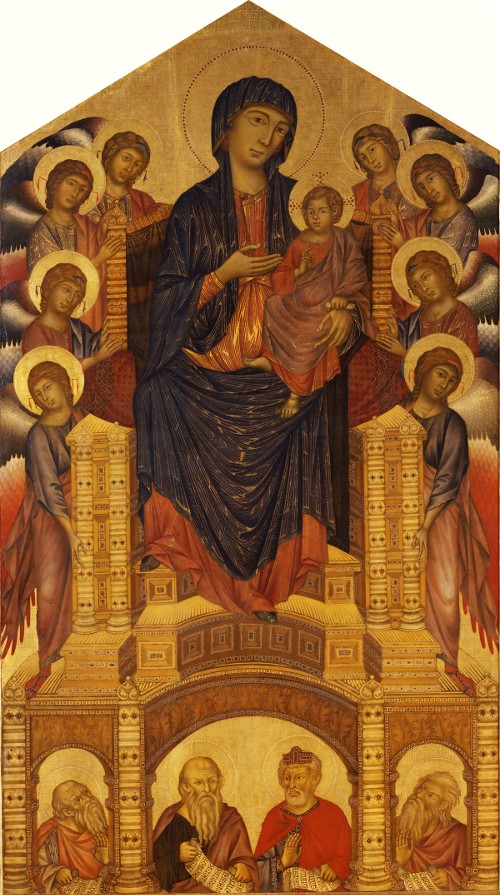
1. Cimabue: Madonna with Angels and Prophets. (Academy,
Florence.)
Look how the human
eye, for instance, is drawn so that you can clearly see: It is
not copied, but done by following with inner feeling the forces
which were believed to be at work, moulding the eye organically
in the body. The inner activity of the eye is feelingly traced
out, — this is what inspires the forms. Plastically
conceived, it is projected in the spirit on to the flat surface.
In the background, as you can still see by these pictures, is the
conception (far more familiar in the Orient than in the West) of
something working in with abundant power from distant worlds.
When in that time men let these pictures with their golden
background work upon them, they had the feeling of a mighty
overwhelming force pouring in from distant worlds into mankind.
It was as though all the human confusion upon Earth was only
there to be illumined by the Impulses proceeding from a reality
beyond, which was pictured in this way.
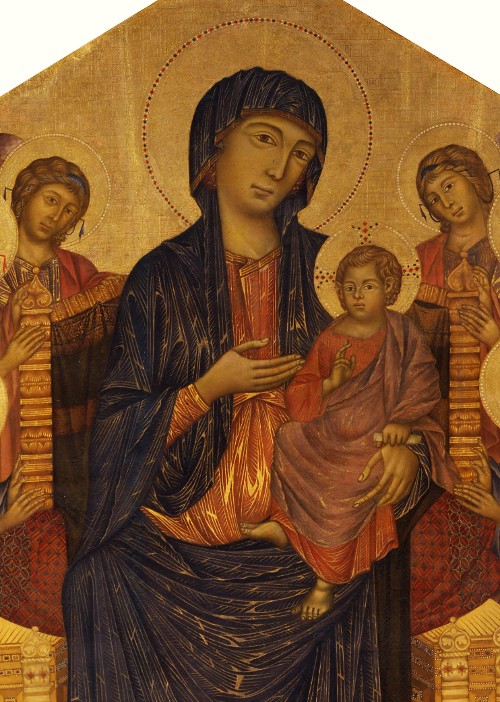
2. Cimabue: Madonna (Detail)
Once more a
picture of the Madonna. This, then, is what we have of
Cimabue.
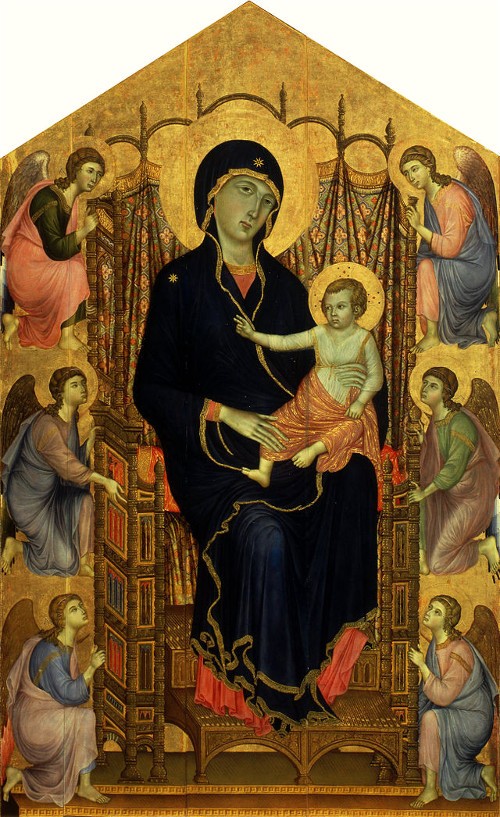
3. Cimabue: Madonna Rucellai. (Santa Maria Novella,
Florence.)
We now pass on to
the study of an artist who, for the external history of art, is,
in a sense, Cimabue's successor. The legend has it that Cimabue
found Giotto as a shepherd-lad who used to draw on rocks and
stones, with the most primitive materials, the animals and other
creatures which he saw around him in the fields. Cimabue,
recognising the great talents of the boy, took him from his
father and trained him in painting. Such legends are often truer
than the outward ‘historic’ truth. It is true, as the
legend suggests, that Giotto — Cimabue's great follower in
the further development of art — was inspired in his inner
life by the whole world in which he found himself through all
that had been created by those whom we include under Cimabue's
name. It is true, indeed, that a whole world of things from
beyond the Earth looked down upon Giotto from the walls around
him. (All this is no longer extant, for reasons we shall
afterwards discuss.) On the other hand, we must never forget that
with Giotto an entirely new artistic world-conception arose in
the West. Indeed, it is Giotto, above all, who in the realms of
art represents the rise of the new age, the 5th post-Atlantean
age. In painting, the 4th post-Atlantean age goes down with
Cimabue; the 5th begins with Giotto. (I leave out of account
whether all the works which a well-founded tradition ascribes to
Giotto were actually painted by him; for that is not the main
point. It is true that under Giotto's name many works are
included of which we can but say that they are painted in his
spirit. Here, however, I will not go into this question, but
simply ascribe to Giotto what tradition has ascribed to him.)
What was mankind
entering into during that time, when we find Dante and Giotto
side by side on the scene of history? It was entering into what I
have always described as the fundamental characteristic of the
5th Post-Atlantean period: into a life in the midst of
earthly-material realities. This must not be taken as a hostile
criticism of Materialism. The time had to come to mankind to
enter fully into the material reality, taking leave for a time of
those things to which they had hitherto looked up and whose light
we find reflected still in Cimabue's paintings.
We may ask
ourselves this question: Who was the first really genuine
materialist? Who was it gave the very first impetus to
materialism? Considering the matter from a somewhat higher point
of view, we shall arrive at an answer which will, of course,
sound paradoxical to modern ears. Nevertheless, for a deeper
conception of human history it is fully justified. I mean that
the first man to introduce the material way of feeling into the
soul-life of mankind was St. Francis of Assisi. I admit it is a
paradox to describe the holy man of Assisi as the first great
materialist, and yet it is so. For one may truly say: the last
great conceptions in which the evolution of mankind is still
described from a standpoint beyond the Earth come before us in
the Divina Commedia of Dante. Dante's great work is to be
regarded as a last expression of a consciousness still directed
more to the things beyond the Earth. On the other hand the vision
of the soul turned to the Earth, the sympathy with earthly
things, comes forth with all intensity in Francis of Assisi, who,
as you know, was before Dante's time. Such things always appear
in the soul-life of mankind a little earlier than their
expression in the realm of art. Hence we see the same impulses
and tendencies which seized the artistic imagination of Giotto at
a later time, living already in the soul of Francis of Assisi.
Giotto lived from 1266 to 1337. Francis of Assisi was a man who
came forth entirely from that kind of outer world which Roman
civilisation, under manifold influences, had gradually brought
forth. To begin with, his whole attention was turned to outer
things. He delighted in the splendour of external riches; he had
enjoyment in all things that make life pleasant, or that enhance
man's personal well being. Then suddenly, through his own
personal experiences his inner life was revolutionised. It was at
first a physical illness which turned him altogether away from
his absorption in external things and turned him to the inner
life. From a man who in his youth was altogether addicted to
external comfort, splendour, reputation, we see him change to a
life of feeling directed purely to the inward things of the soul.
Yet all this took place in a peculiar and unique way. For Francis
of Assisi became the first among those great figures who, from
that time onwards, turned the soul's attention quite away from
all that sprang from the old visionary life. He, rather, turned
his gaze to that which lives and moves immediately upon the
Earth, and above all to man himself. He seeks to discover what
can be experienced in the human soul, in the human being as a
whole, when we see him placed alone, entirely upon his own
resources. St. Francis was surrounded by mighty world-events
which also took their course on Earth, if I may put it so, in
such a way as to sweep past the single life of man, even as the
rich imaginations of an earlier Art had represented sublime
Beings gazing down from beyond the Earth into this world of human
feeling. For in his youth, and later, too, St. Francis was
surrounded by the world-historic conflict of the Guelphs and
Ghibellines. Here one might say there was a battling in greater
spheres, for impulses transcending what the single man on Earth
feels and experiences — impulses for which the human being
on the Earth were but the great and herd-like mass. Right in the
midst of all this life, St. Francis with his ever more numerous
companions upholds the right of the single human individuality,
with all that the inner life of man can experience in connection
with the deeper powers that ensoul and radiate and sparkle
through each human soul. His vision is directed away from
all-embracing cosmic, spiritual spheres, directed to the
individual and human life on Earth. Sympathy, compassion, a life
in fellowship with every human soul, an interest in the
experiences of every single man, a looking away from the golden
background whose splendour, inspired by oriental fancy, had
radiated in an earlier art from the higher realms on to the
Earth. St. Francis and his followers, looking away from all these
things, turned their attention to the joys and sufferings of the
poor man on Earth. Every single man now becomes the main concern,
every single man a world in himself. Yes, one desires to live in
such a way that every single man becomes a world. The Eternal,
the Infinite, the Immortal shall now arise within the breast of
man himself, no longer hovering like the vast and distant sphere
above the Earth.
Cimabue's pictures
are as though seen out of the clouds. It is as though his figures
were coming from the clouds towards the Earth. And so, indeed,
man had felt and conceived the Spiritual World hitherto. We today
have no idea how intensely men had lived with these transcendent
things. Hence, as a rule, we do not realise how immense a change
it was in feeling when St. Francis of Assisi turned the life of
the West more inward. His soul wanted to live in sympathy with
all that the poor man was; wanted to feel the human being
especially in poverty, weighed down by no possessions, and,
therefore, valued by nothing else than what he simply is as a
man. Such was St. Francis of Assisi; and this was how he sought
to feel not only man but Christ Himself. He wanted to feel what
Christ is for poor simple men. Out of the very heart of a
Christianity thus felt, he then evolved his wondrous feeling for
Nature. Everything on Earth became his brother and his sister; he
entered lovingly not only into the human heart but into all
creatures. Truly, in this respect St. Francis is a realist, a
naturalist. The birds are his brothers and his sisters; the
stars, the sun, the moon, the little worm that crawls over the
Earth — all are his brothers and his sisters; on all of
them he looks with loving sympathy and understanding. Going along
his way he picks up the little worm and puts it on one side so as
not to tread it underfoot. He looks up with admiration to the
lark, calling her his sister. An infinite inwardness, a life of
thought unthinkable in former times, comes forth in Francis of
Assisi. All this is far more characteristic of St. Francis than
the external things that are so often written about his life.
So we might say,
man's gaze is now made inward and centered upon the earthly life;
and the influence of this extends, by and by, to the artistic
feeling. For the last time, we might say, Dante in his great poem
represents the life of man in the midst of mighty Powers from
beyond the Earth; but Giotto, his contemporary and probably his
friend, Giotto in his paintings already brings to expression the
immediate interest in all that lives and moves on Earth. Thus we
see, beginning with Giotto's pictures, the faithful portrayal of
the individual in Nature and in Man. It is no mere chance that
the paintings ascribed to Giotto in the upper church at Assisi
deal with the life of St. Francis, for there is a deep inner
connection of soul between Giotto and Francis of Assisi —
St. Francis, the religious genius, bringing forth out of a
fervent life of soul his sympathy with all the growth of Nature
upon Earth; and Giotto, imitating, to begin with, St. Francis'
way of feeling, St. Francis' way of entering into the spirit and
soul of the world.
Thus we see the
stream of evolution leading on from Cimabue's rigid lines and
two-dimensional conception, to Giotto, in whose work we see
increasingly the portrayal of the natural, individual creature,
the reality of things seen; we see things standing more and more
in space, rather than speaking to us out of the flat surface.
We will now give
ourselves up to the immediate impression of Giotto's pictures,
one by one. We shall see his growing appreciation of the
individual human character and figure. Giotto shows himself with
all the greater emphasis inasmuch as his pictures deal with the
sacred legend, and so he tries to reproduce in the outward
expression the inmost and intensest life of the soul.
Now, therefore, we
shall have before us a series of Giotto's pictures, beginning
with those that are generally regarded as his earliest. You will
still see in them the tradition of the former time, but along
with it there is already the human element, in the way in which
he knew it — the way that I have just described.
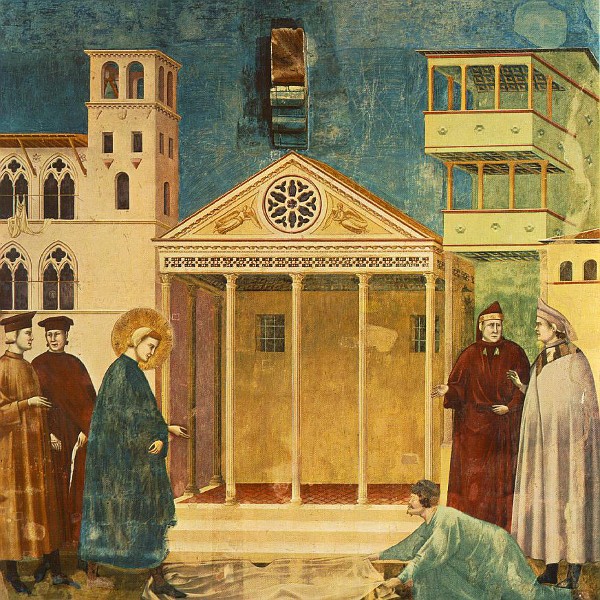
4. Giotto: Glorification of St. Francis. (San Francesco,
Assisi)
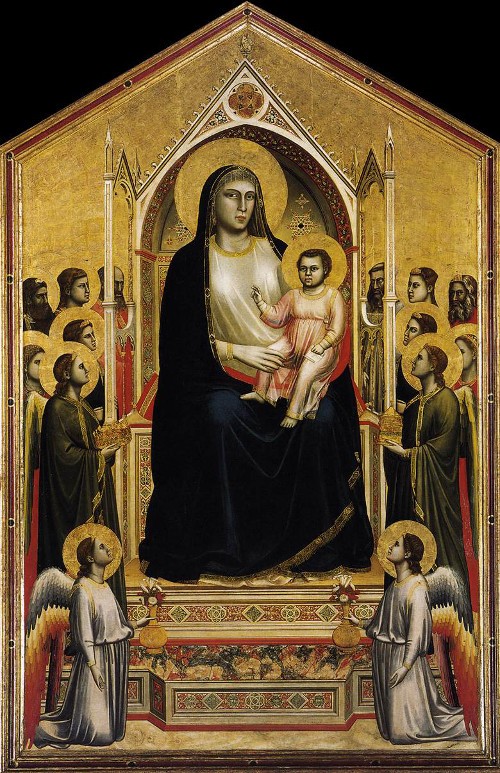
5. Giotto: Madonna enthroned. (Alter-piece, Santa Croce,
Florence.)
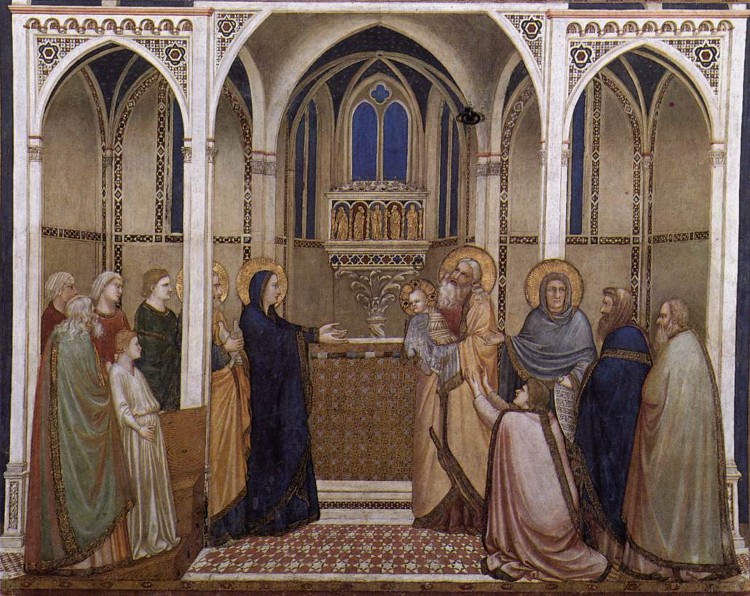
6. Giotto: Presentation in the Temple, (San Francesco,
Assisi.)
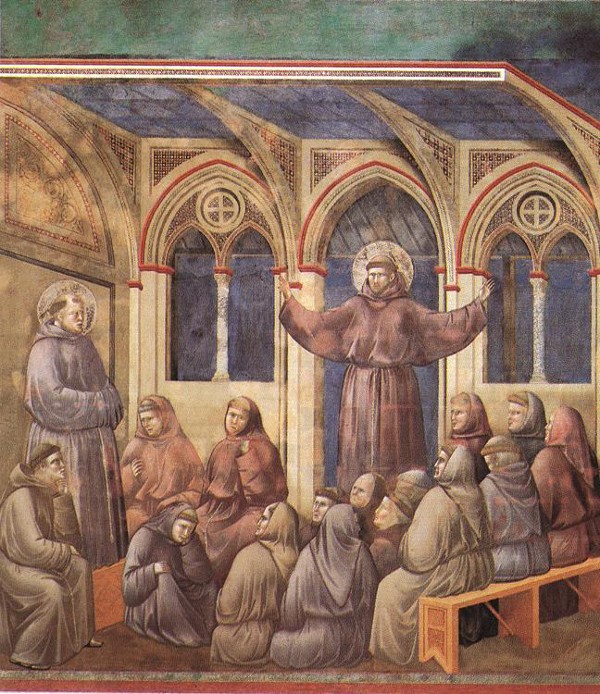
7. Giotto: Apparition in Arles. (San Francesco, Assisi.)
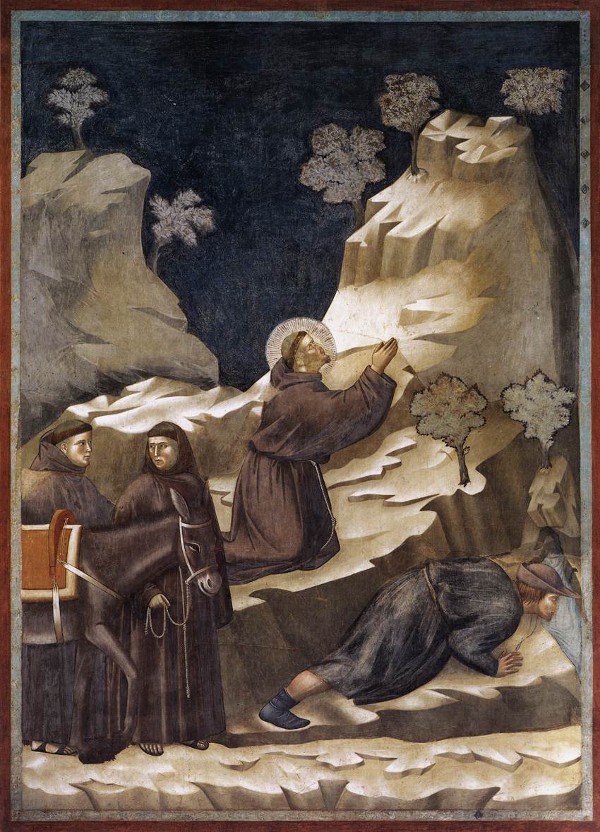
8. Giotto: The Miracle of the Spring. (San Francesco,
Assisi.)
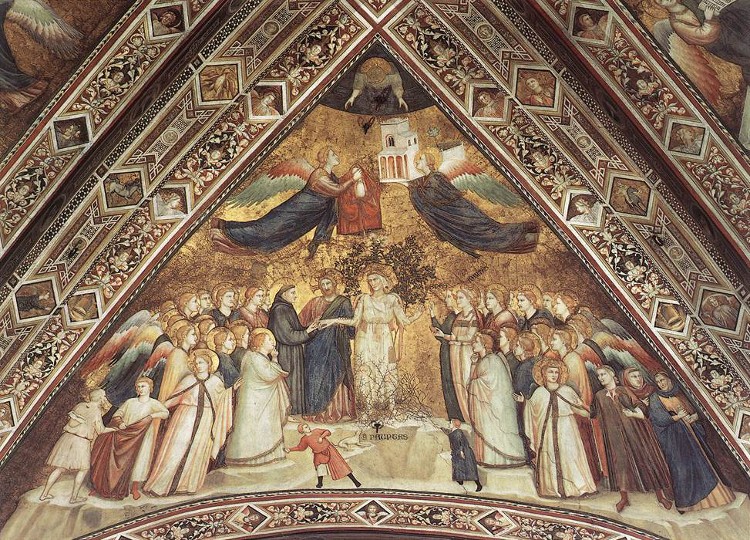
9. Giotto: Poverty. (San Francesco, Assisi.)
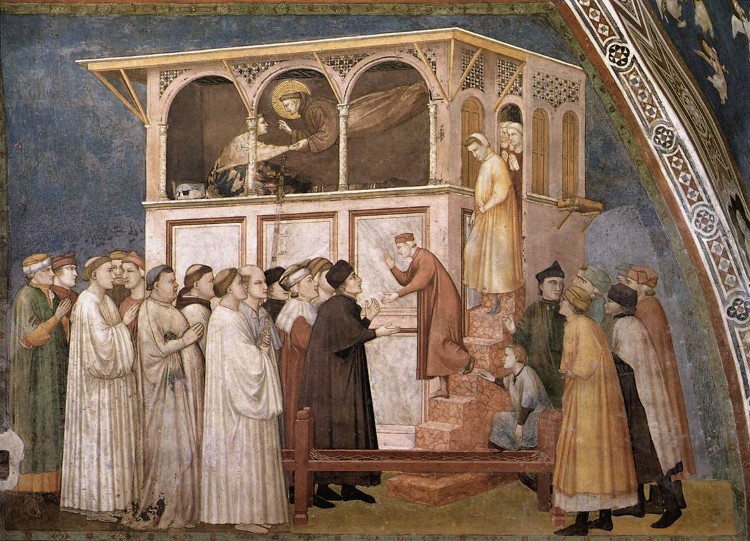
10. Giotto: Awakening of the Youth of Suessa. (San
Francesco, Assisi.)
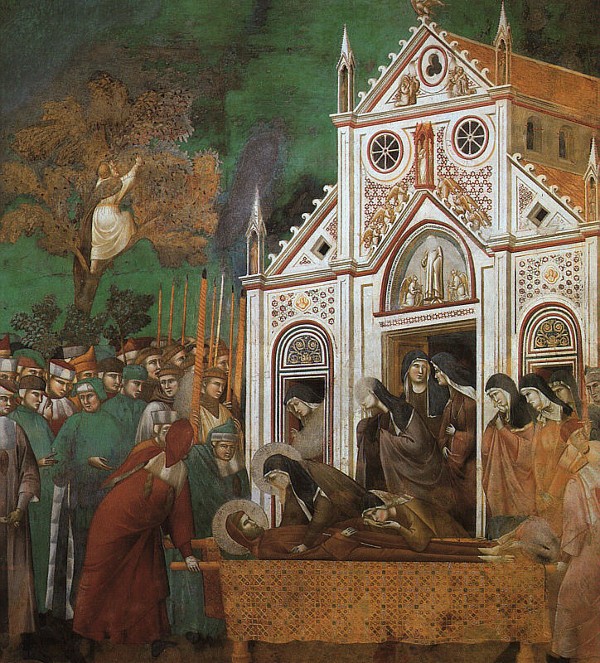
11. Giotto: The Mourning for St. Francis by the Nuns. (San
Francesco, Assisi.)
Thus gradually the
whole life of St. Francis was painted by Giotto; and everywhere
in his artistic work we find a feeling similar to that of St.
Francis himself. Even when you take the visionary elements in
these pictures, you will see how his effort is in every case to
paint them from within, so that the language of human feeling is
far more in evidence than in the pictures of Cimabue, who was
concerned only with the gazing inward of transcendent impulses
from spheres beyond the Earth. Again, in the faces themselves you
will no longer find the mere traditional expression, but you will
see in every case: The man who painted these pictures had really
looked at the faces of men.
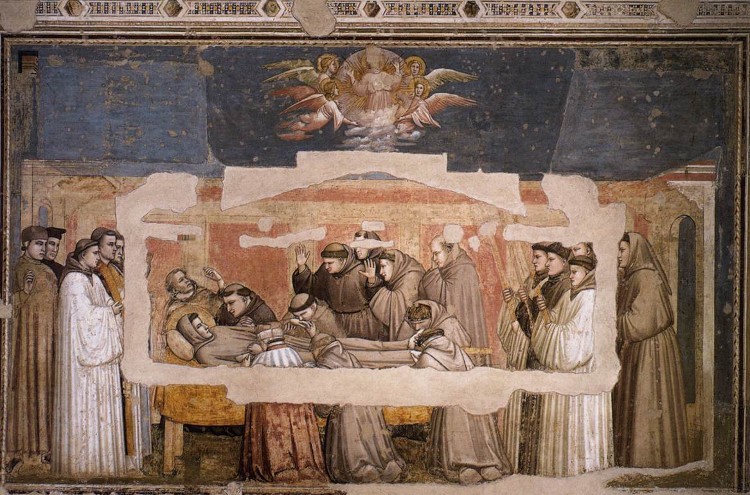
12. Giotto: Death of St. Francis. (Santa Croce,
Florence.)
Look at these last
two pictures. Their inherent tenderness recalls to us the
beautiful fact that is related of the life of St. Francis. He had
long been working at his Hymn to Nature — the great and
beautiful hymn throughout which he speaks of his brothers and his
sisters, of sisters Sun and Moon and the other planets, and of
all earthly creatures. All that he had felt in loving, realistic
devotion of his soul, in sympathy with Nature, is gathered up so
wonderfully in this hymn. But the directness of his union with
all earthly Nature finds expression most of all in this beautiful
fact that the last verse wherein he addresses Brother Death was
written in the very last days of his life. St. Francis could not
sing the hymn of praise to Brother Death till he himself lay
actually on his deathbed, when he called to his brothers that
they should sing around him of the joys of death while he felt
himself going out and out into that World which was now to
receive his spirit. It was only out of the immediate, realistic
experience that St. Francis could and would describe his tender
union with all the world. Beautifully this is revealed in the
fact that while he had sung the Hymn of Praise to all other
things before, he only sang to Death when he himself was at
Death's door. The last thing he dictated was the final verse of
his great Hymn of Life, which is addressed to Brother Death, and
shows how man, when he is thrown back upon himself alone,
conceives the union of Christ with human life. Surely it cannot
be more beautifully expressed than in this picture, revealing the
new conception of human life that was already pouring from out
St. Francis, and showing how directly Giotto lived in the same
aura of thought and feeling.
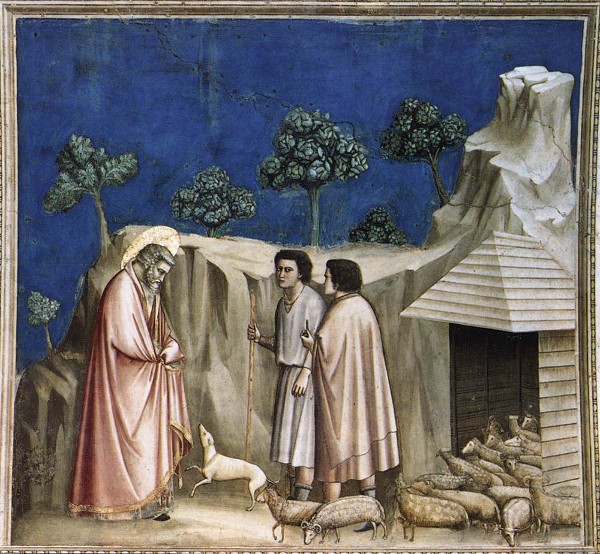
13. Giotto: Joachim and the Shepherds. (Capella Madonna,
Padua.)
I have inserted
this later picture, so that you may see the progress Giotto made
in his subsequent period of life. You see how the figures here
are conceived still more as single human individuals. In the
period from which the former pictures were taken, we see the
artist carried along, as it were, by the living impulses of St.
Francis. Here in this picture, belonging as it does to a later
period of his life, we see him coming more into his own. We will
presently return to the pictures more immediately following his
representations of St. Francis.
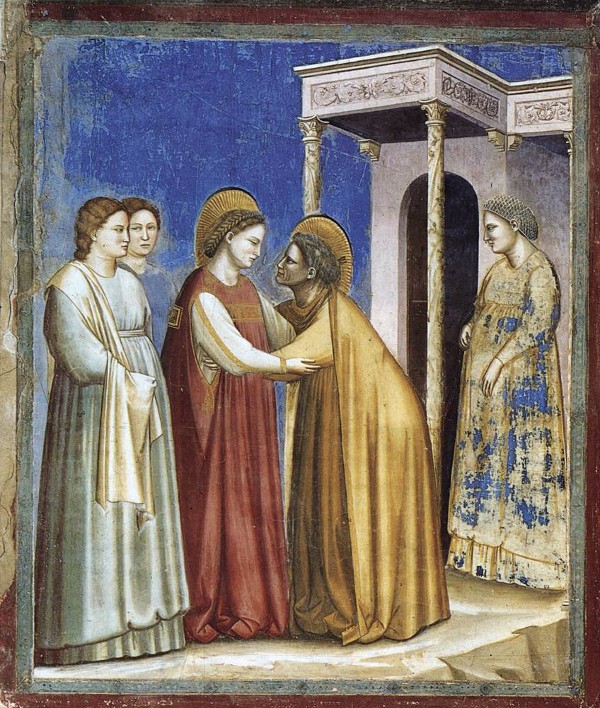
14. Giotto: The Visitation. (Capella Madonna dell' Arena,
Padua.)
This, too, is from
his later period, showing a consideraby greater realism than
before.
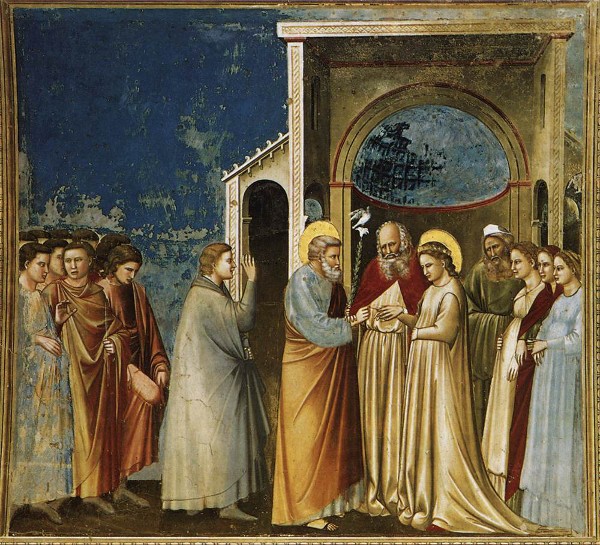
15. Giotto: Marriage of the Virgin. (Capella Madonna
dell'Arena, Padua.)
Also of his later
period.
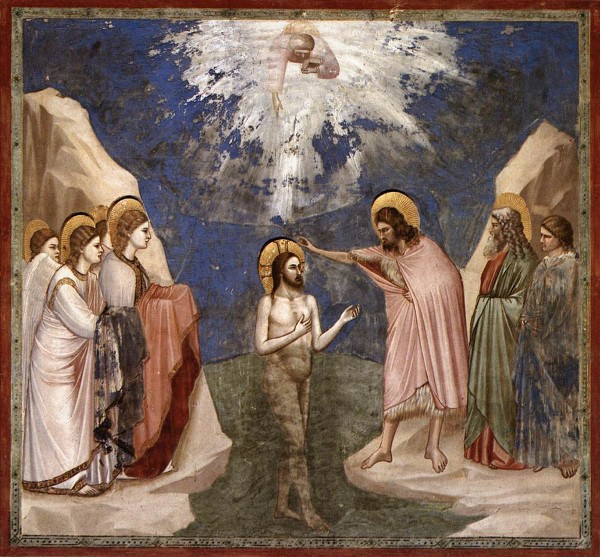
16. Giotto: The Baptism of Christ. (Capella Madonna dell'
Arena, Padua.)
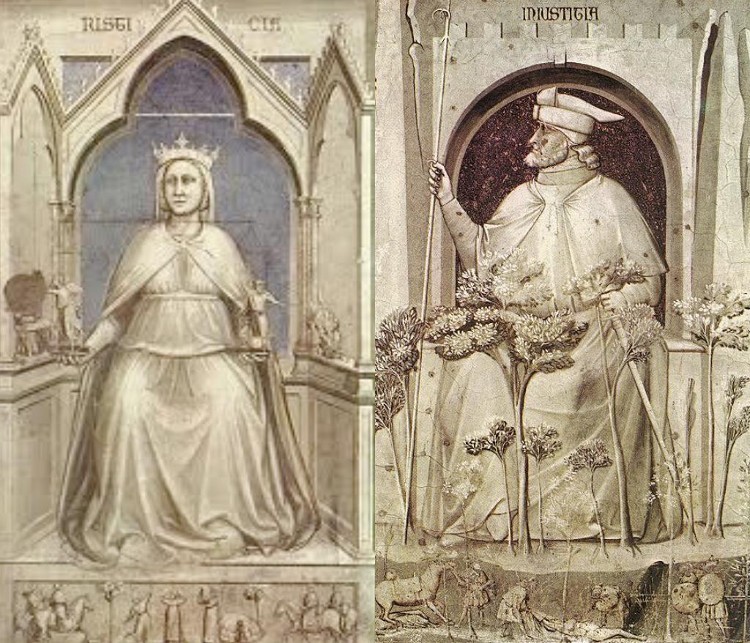
17. Giotto: Justice and Injustice. (Capella Madonna dell'
Arena, Padua.)
In such pictures we
see how natural it was to the men of that age to express
themselves in allegories. The conditions of life undergo immense
changes in the course of centuries. It was a tremendous change
when the life that had found expression in pictures at that time,
passed over into that in which we live today, which takes its
course more in thoughts and ideas communicated through the medium
of books. This was a far greater revolution than is generally
realised. The desire to express oneself in allegories was
especially strong in that age. It is most interesting to see how
in such a case artistic realism is combined with the striving to
make the whole picture like a Book of the World in which the
onlooker may read.
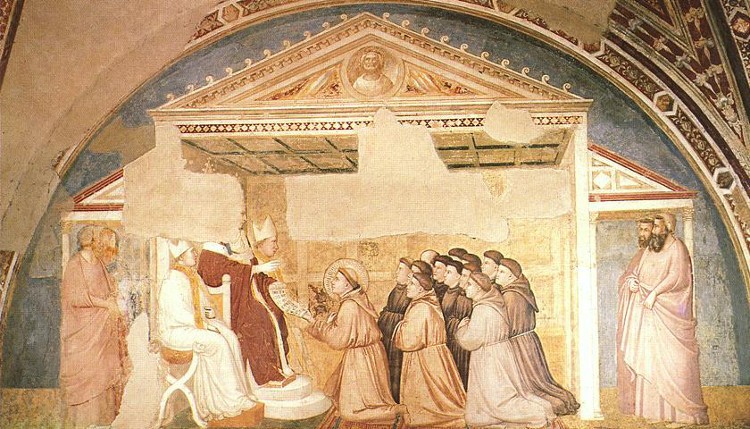
18. Giotto: St. Francis submits the Rules of his Order to the
Pope. (Santa Croce, Florence.)
This picture is
related once more the earlier art of Giotto — springing as
it does from his increasing entry into the whole world of feeling
of St. Francis of Assisi.
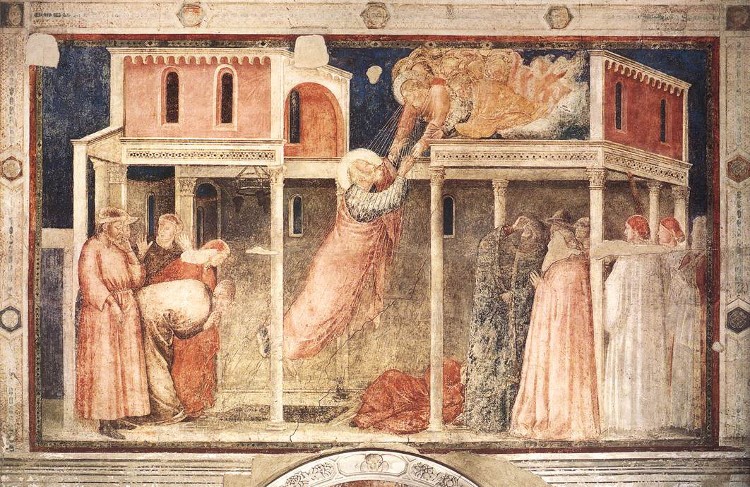
19. Giotto: The Ascension.of John the Evangelist. (Santa
Croce, Florence.)
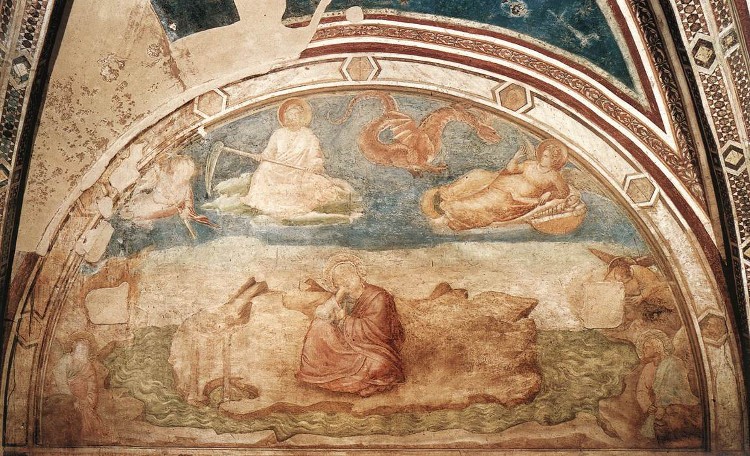
20. Giotto: St. John in Patmos. (Santa Croce,
Florence.)
Beautifully we see
how the artist seeks to represent the inner life of St. John,
bringing forth out of his heart his inner connection with the
great World. This, then, is St. John, writing, or at least
conceiving, the Apocalypse.
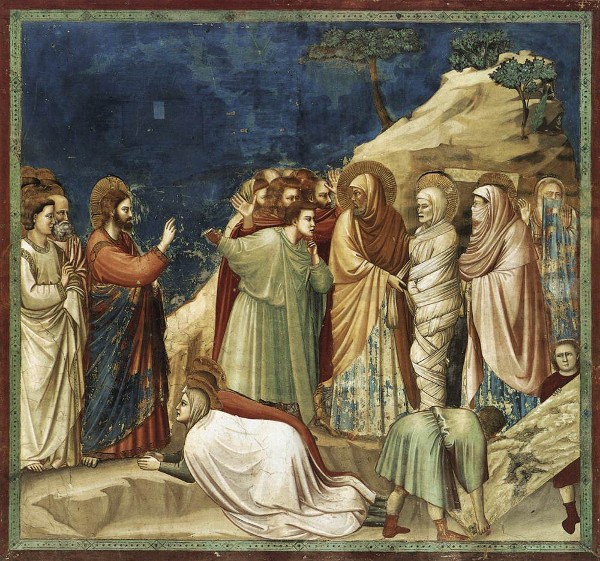
21. Giotto: The Raising of Lazarus.
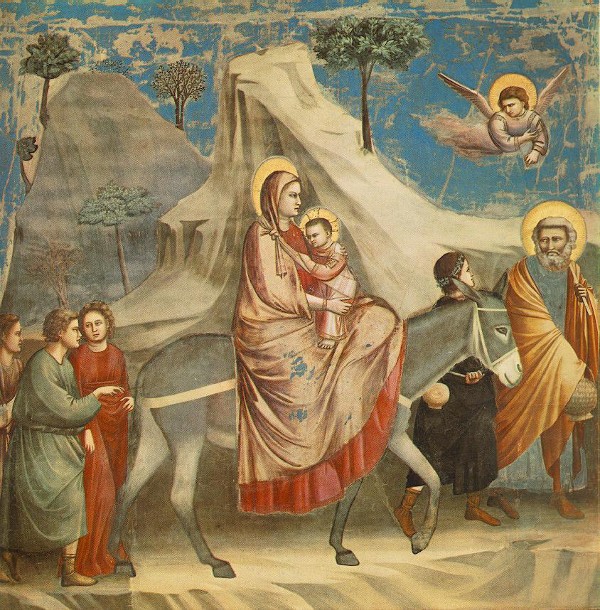
22. Giotto: The Flight into Egypt.
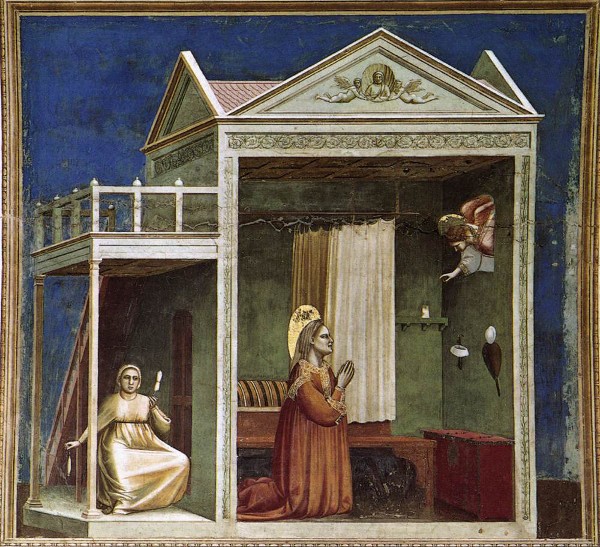
23. Giotto: The Annunciation to St. Anne.
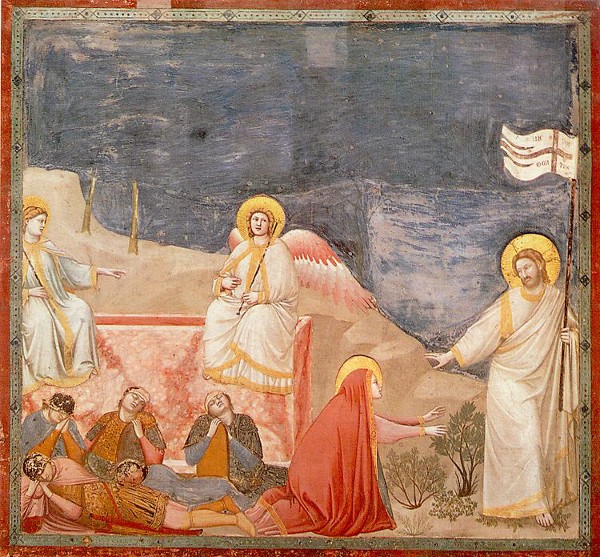
24. Giotto: The Resurrection of Christ. (Capella Madonna
dell' Arena, Padua.)
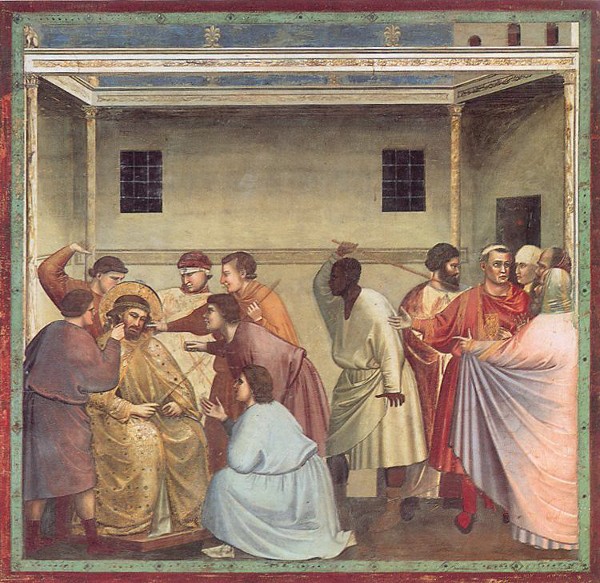
25. Giotto: The Crowning with Thorns. (Capella Madonna
dell' Arena, Padua.)
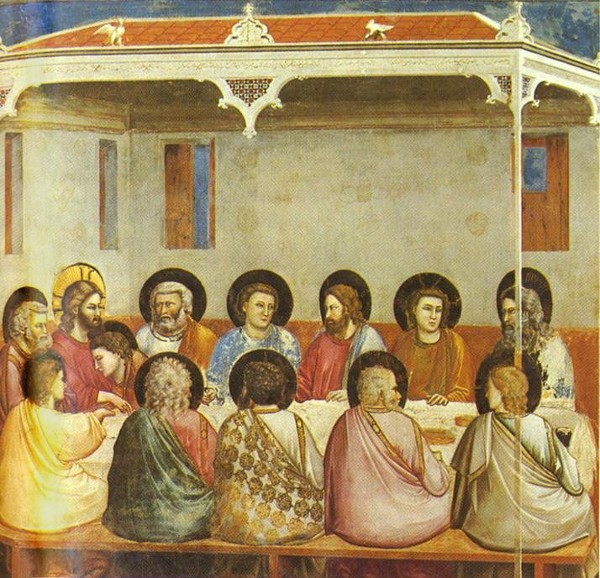
26. Giotto: The Last Supper. (Capella Madonna dell' Arena,
Padua.)
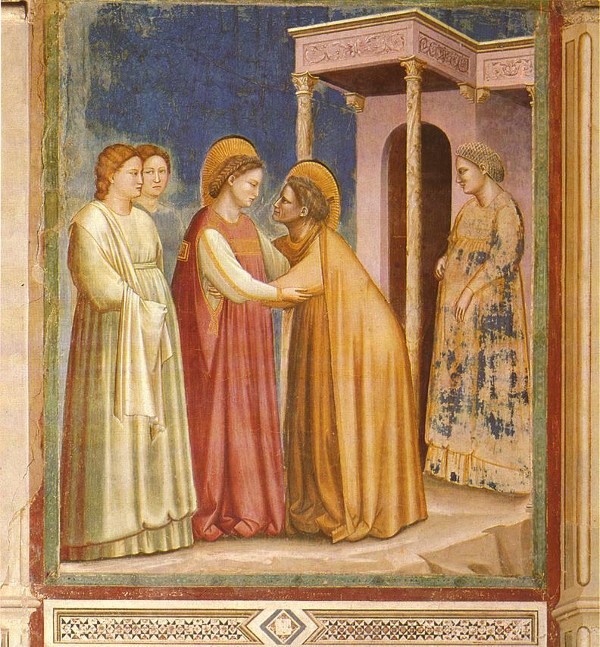
27. Giotto: The Visitation. (San Francesco, Assisi.)

28. Giotto: Madonna. (Academy, Florence.)
We will insert,
directly after this Madonna by Giotto, the Madonna by Cimabue
which we have already seen, so that you may recognise the immense
difference in the treatment of the sacred figure. Observe —
despite the obvious persistence of the old tradition — the
realism of this picture, in the eyes, the mouth, and the whole
conception of the Jesus child. We have before us human beings,
copied from the reality of earthly life, looking out from the
Earth into the World. Compare this with Cimabue's picture, where
we rather have before us an original spiritual vision
traditionally handed down — where Beings gaze from realms
beyond the Earth into this world.

29. Cimabue: Madonna enthroned. (Academy, Florence.)
(This is No. 1 repeated.)
However much in the
composition is reminiscent of the former picture, you will see,
even in the way the lines are drawn, the immense difference
between the two.
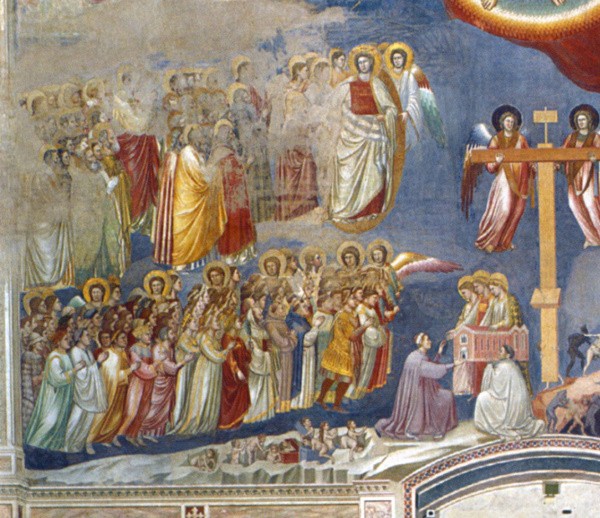
30. Giotto: The Last Judgment. (Detail.) (Capella Madonna dell'
Arena, Padua.)
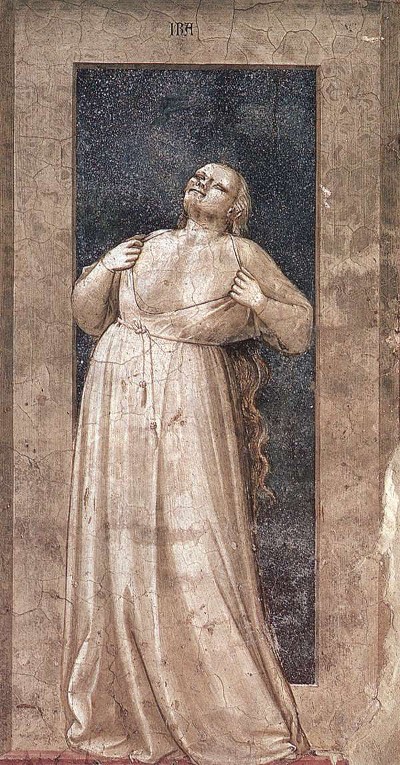
31. Giotto: Anger. (Capella Madonna dell' Arena. Padua.) Once
more an allegorical picture.
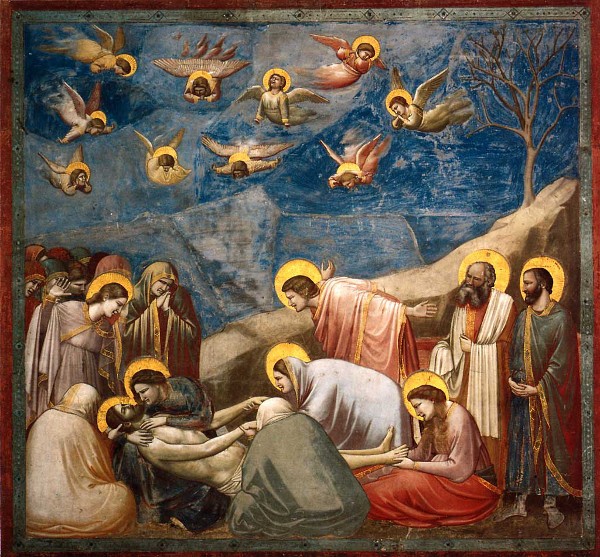
32. Giotto: Mourning for Christ.
It is interesting
to compare this picture with the “Mourning for St.
Francis” which we saw before. The former was an earlier
work, while this belongs to a very late period in Giotto's life.
We will now insert the previous one once more so that you may see
the great progression. This picture is taken from the chapel in
Padua, where Giotto returned once more to the former legend.

33. Giotto: Mourning for St. Francis. (San Francesco,
Assisi.) No. 11 repeated.
Here, then, you see
how he treats a very similar subject so far as the composition is
concerned, at an earlier and at a much later stage in his career.
Observe the far greater freedom, the far greater power to enter
into individual details which the later picture reveals.
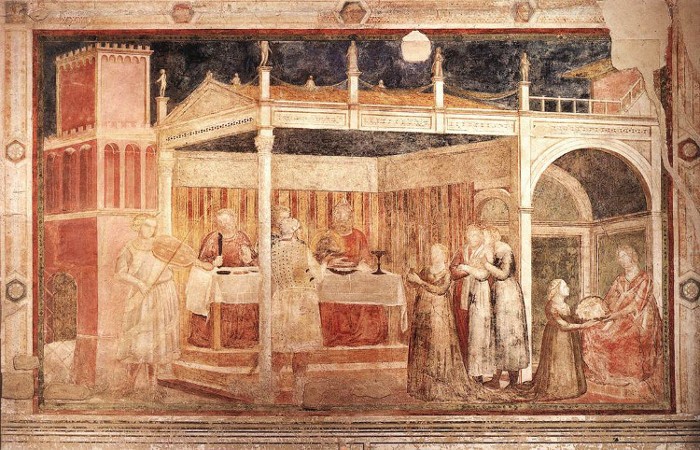
34. Giotto: The Feast of Herod. (Santa Croce, Florence.)
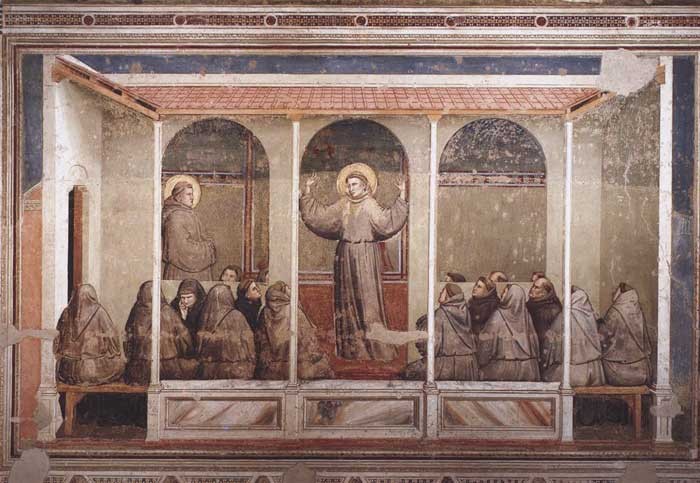
35. Giotto: The Appearance in Arles. (Santa Croce, Florence.)
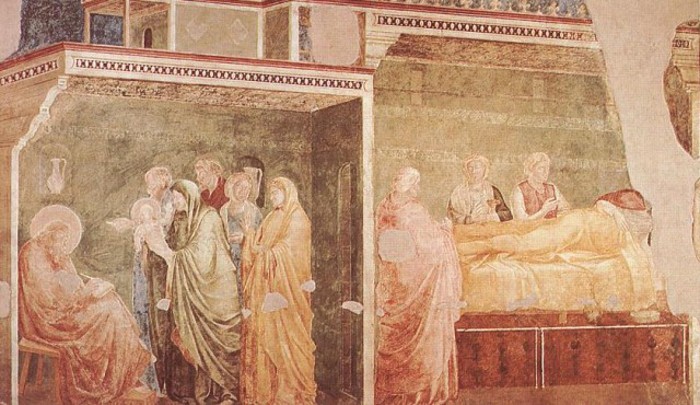
36. Giotto: Birth and Naming of John the Baptist. (Santa
Croce.)
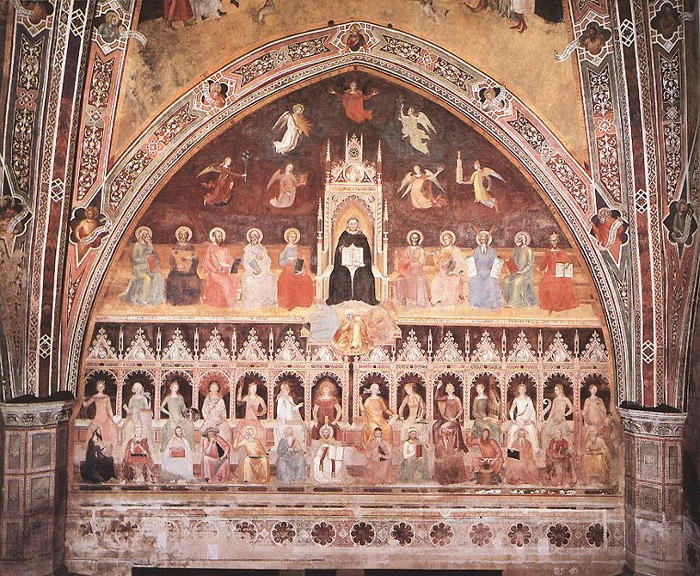
37. Andrea da Firenze (School of Giotto): Doctrine of the
Church. (Spanish Chapel, Santa Maria Novella. Florence.)
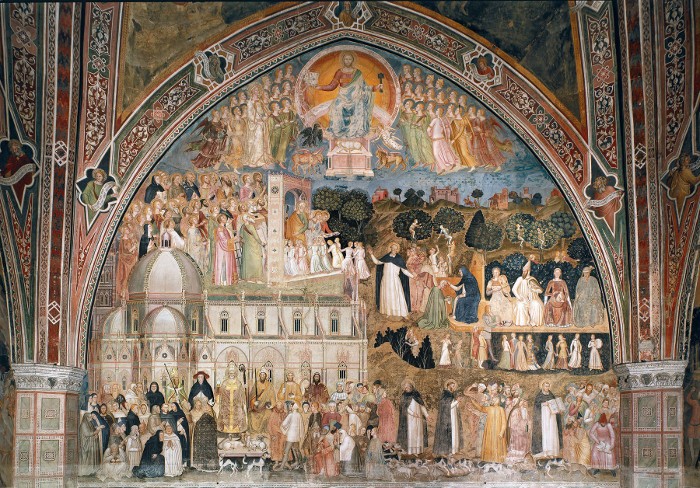
38. Andrea da Firenze (School of Giotto): The Church
Militant. (Spanish Chapel, Santa Maria Novella,
Florence.)
This picture, the
Church Militant, is generally associated with the School of
Giotto. Here you see the rise of that compositional element which
was to play so great a part in the subsequent history of
painting. Quite a new inner life appears before us here. We may
describe the difference somewhat as follows:
If we consider the
evolution of Christianity until the time of Dante and Giotto, we
shall find a strong element of Platonism in its whole way of
feeling. Far be it from me to mislead you into the belief that it
contained the Platonic Philosophy; but Platonism, that is to say,
a feeling and conception of the world which also finds expression
in the philosophy of Plato, where man looks up into a sphere
beyond the Earth, and does not carry into it anything that
proceeds from the human intellect. After Giotto's time a
theological, Aristotelian element entered more and more into the
Christian world of feeling. Once again I do not say the
philosophy of Aristotle, but a theological, Aristotelian quality.
Men tried, as it were, to see and summarise the world in
systematic conceptions such as you see in this picture, rising
upward from a world below to a middle and thence to a higher
world. Thus was the whole of life systematised through and
through in an Aristotelian manner. So did the later Church
conceive the life of man placed in the universal order. Past were
the times from which Cimabue still rayed forth, when men's
conception of a world beyond the Earth proceeded still from the
old visionary life. Now came a purely human way of feeling; yet
the desire was, once more, to lead this human feeling upward to a
higher life — to connect it with a higher life, only now in
a more systematic, more intellectual and abstract way. And so, in
place of the Earlier Art, creating as from a single centre of
spiritual vision, there arose the new element of composition. See
the three tiers, rising systematically into higher worlds from
that which is experienced and felt below. Observing this in the
immediate followers of Giotto, you will already have a
premonition, a feeling of what was destined to emerge in the
later compositions. For who could fail to recognise that the same
spirit which holds sway in the composition of this picture meets
us again in a more highly evolved, more perfect form, in
Raphael's Disputa.
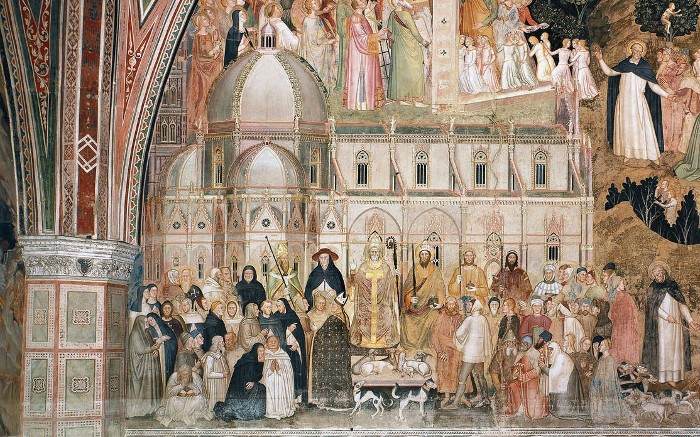
39. Andrea da Firenza (School of Giotto): The Church
Militant. (Detail.) (Santa Maria Novella, Florence.)
See how the
spiritual events and processes of earthly life are portrayed in
the grouping of the human figures. It is the same artistic
conception which emerges in Raphael's great picture, generally
known as the 'School of Athens.' Human beings are placed together
to express the relationships that hold sway in earthly life.
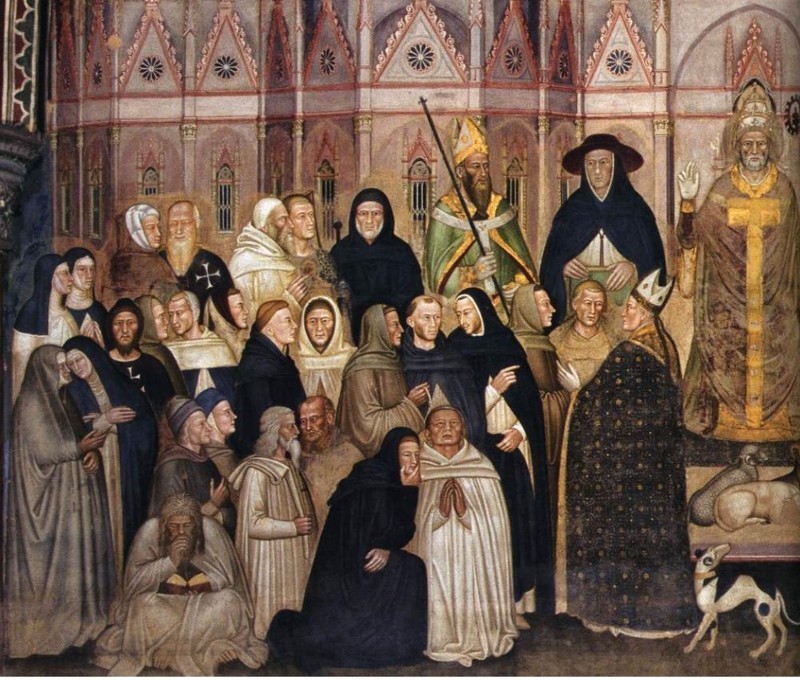
40. Andrea da Firenze. (School of Giotto): The Church
Militant. (Detail.)
I beg you
especially to observe the unique way in which the fundamental
idea comes to expression here: in the background the mighty
building of the Church, and then, throughout the picture, the
power going forth from the Church dignitaries, poured out into
the world of the common people. Look at the expression of the
faces. See how the artist's work is placed at the service of this
grand idea: The rule of the Church raying out over the Earth. You
may study every single countenance. Wonderfully it is expressed
— raying outward from the centre — how each single
human being partakes in the impulse that is thought to proceed
from the Church through all the souls on Earth. The physiognomies
are such that we see clearly: The whole thing was done by an
artist who was permeated by this idea, and was well able to bring
to expression in the countenance of men what the Church Militant
would, indeed, bring into them. We see it raying forth from every
single face. I beg you to observe this carefully, for in the
later pictures which we shall see afterwards it does not come to
expression with anything like the same power. Though the
fundamental idea of the composition — expressed so
beautifully here, both in the grouping of the figures and in the
harmony between the grouping and the expressions of the faces
— though the fundamental impulse was retained by later
artists, nevertheless, as you will presently see for yourselves,
it was an altogether different element that arose in their
work.

Look at the dogs
down here: they are the famous Domini Canes, the hounds of
the Lord, for the Dominicans were spoken of in connection with
the hounds of Lord. Angelico represents these Domini Canes
in many of his pictures.
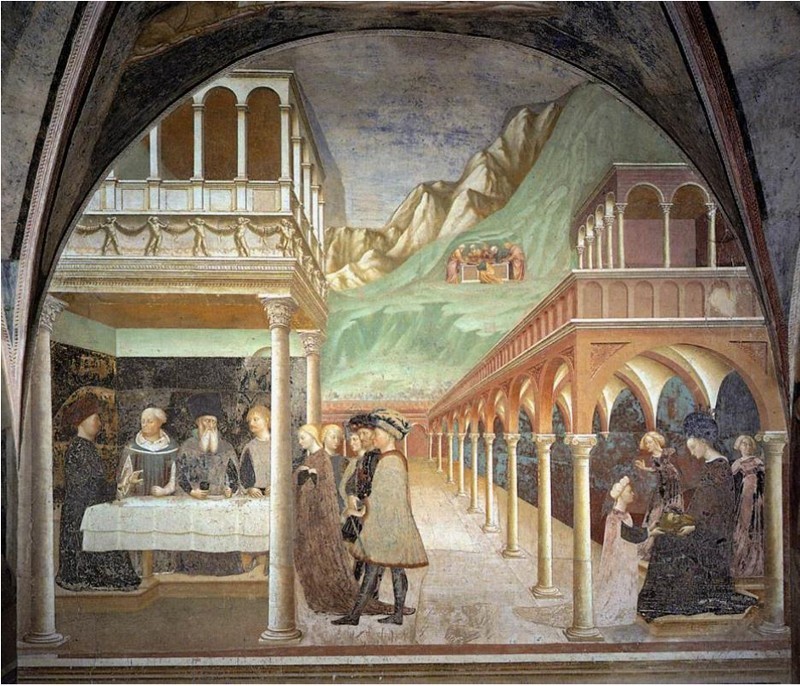
41. Tommaso Fini (Masolino): Feast of Herod.
(Tapistry, Castiglione d'Olona.)
Here we come a
stage further in artistic evolution. The following developments
may be said to have proceeded from the stream and impulse of
which Giotto was the great initiator. But from this source a
two-fold stream proceeded. In the one, we see the realistic
impulse emancipating itself more and more from the Spiritual. In
Giotto and in the last two pictures the Spiritual still enters
in, everywhere; for, after all, this impulse proceeding from the
Church Militant throughout the World is conceived as a spiritual
thing. Every single figure in the composition is such that we
might say: Just as St. Francis himself lived after all in a
spiritual world (albeit lovingly, realistically inclined through
his soul to the earthly world around him), Giotto and his pupils,
with 'however loving realism they grasped the things of this
world, still lived within the Spiritual and could unite it with
their conception of the single individual on Earth. But now, as
we come on into the 14th and 15th century, we see the longing,
faithfully to portray the individual and Natural, emancipating
itself more and more. There is no longer that strong impulse to
see the vision as a whole and thence derive the single figures,
which impulse was there in all the former pictures, even where
Giotto and his pupils went to the Biblical story for their
subjects. Now we see the single figures more and more emancipated
from the all-pervading impulse which, until then, had been poured
out like a magic broach ever the picture as a whole. More and
more we see the human figures standing out as single characters,
even where they are united in the compositions as a whole. Look,
for example, at the magnificent building here. Observe how the
artist is at pains, not so much to subordinate his figures to one
root-idea, as to represent in every single one a human
individual, a single character. More and more we see the single
human characters simply placed side by side. Though undoubtedly
there is a greatness in the composition, still we see the single
individuals emancipated naturalistically from the idea that
pervades the picture as a whole.
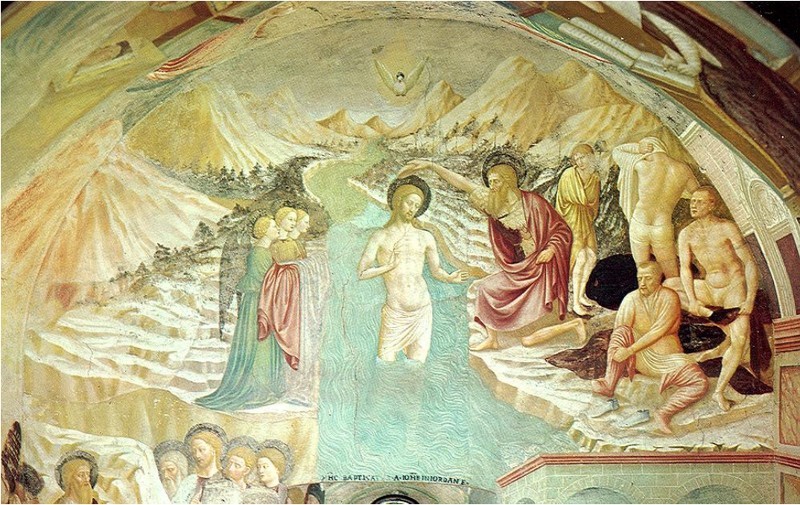
42. Masolino: The Baptism of Christ. (Baptistery.
Castiglione d'Olona.)
Even in this
Biblical picture you can see how the expressions of the several
figures are emancipated from the conception as a whole. Far more
than heretofore, the artist's effort is to portray even the
Christ in such a way that an individual human quality comes to
expression in Him. Likewise the other figures.
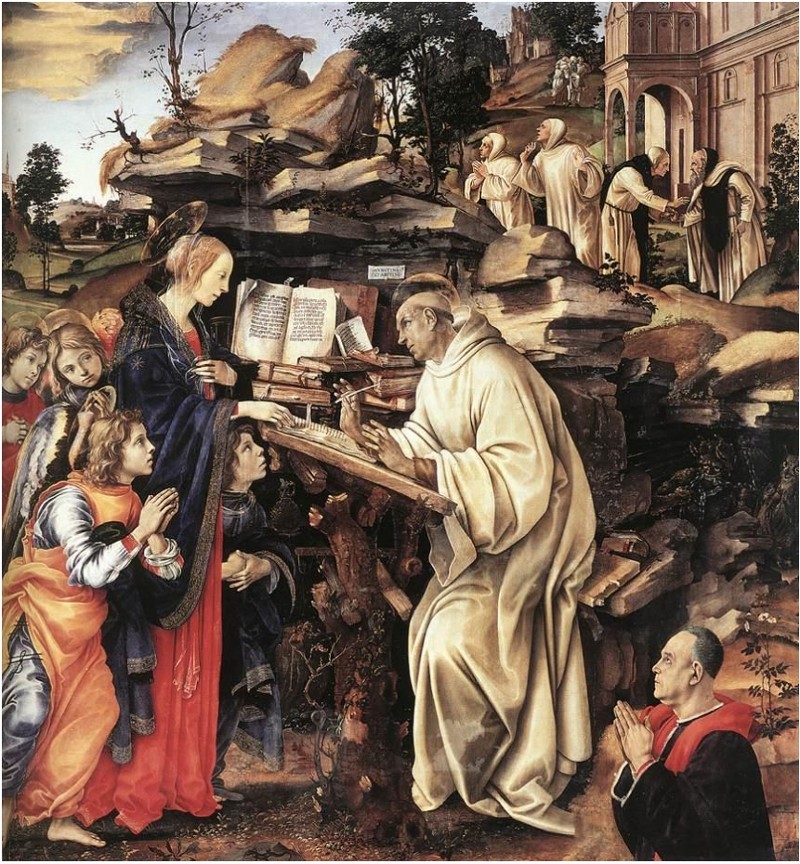
43. Filippino Lippi: Vision of St. Bernard.
(Florence.)
In this picture you
can already lose the feeling of one idea pervading the whole.
See, on the other hand, the wonderful expressions of the faces in
Filippino Lippi's work, both in the central figure of the
visionary and in the lesser figures. In every case the Human is
brought out. Thus we see the one stream, proceeding from the
source to which I just referred, working its way into an ever
stronger realism, till it attains the wondrous inner perfection
which you have before you in this figure of St. Bernard as he
receives his vision.
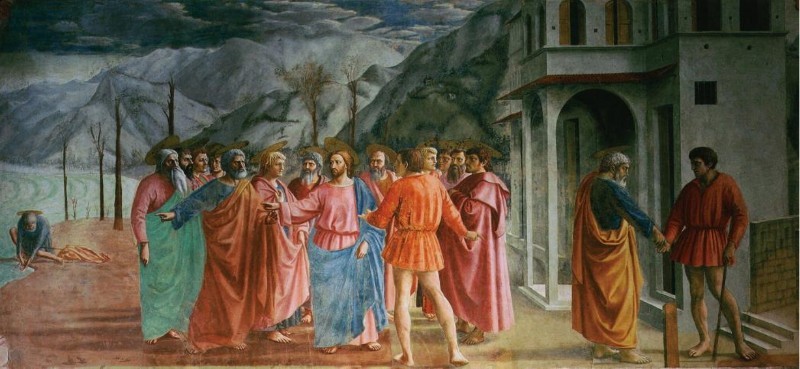
44. Masaccio: The Tribute Money. (Capella
Brancacci-Carmine, Florence.)
Here you see a
wonderful progression in human feeling. Looking at this work of
Masaccio's, you can take a keen interest in every single figure,
in every single head of these disciples grouped around the
Christ. Look, too, how the Christ Himself is individualised.
Think of the tremendous progress in characterisation, from the
pictures which we saw before, to this one. Observe the transition
in feeling. Heretofore it was absorbed in the Christian cosmic
conception. Now it has passed over to the renewed conception of
the Roman power. Feel in this composition, in the expressions of
the several figures, how the Roman concept of power is expressed.
A little while ago we say the Rule of the Church Militant pouring
out as a spiritual force over the whole. Here, for the most part,
are highly individualised figures — men who desire power
and who join together for the sake of power, while in the former
case it was a spiritual light which shone through all their
faces. In the earlier pictures, each was to be understood out of
the whole, while here we can but grasp the whole as a summation
of the individuals, each of whom is, in a sense, a power in
himself. With all the greatness of the composition — the
figures grouped around the mighty one, the Christ, mighty through
His pure spiritual Being, — still you can read in the
expressions of these men: ‘Ours is, indeed, a kingdom not
of this world; yet it shall rule this world,’ — and,
what is more, rule it through human beings, not through an
abstract spiritual force. All this is expressed in the figures of
these men. So you see how the human and realistic element becomes
more and more emancipated, while the artist's power to portray
the individual increases. The sacred legends, for example, are no
longer represented for their own sake. True, they live on, but
the artists use them as a mere foundation. They take their start
from the familiar story, using it as an occasion to represent the
human being.
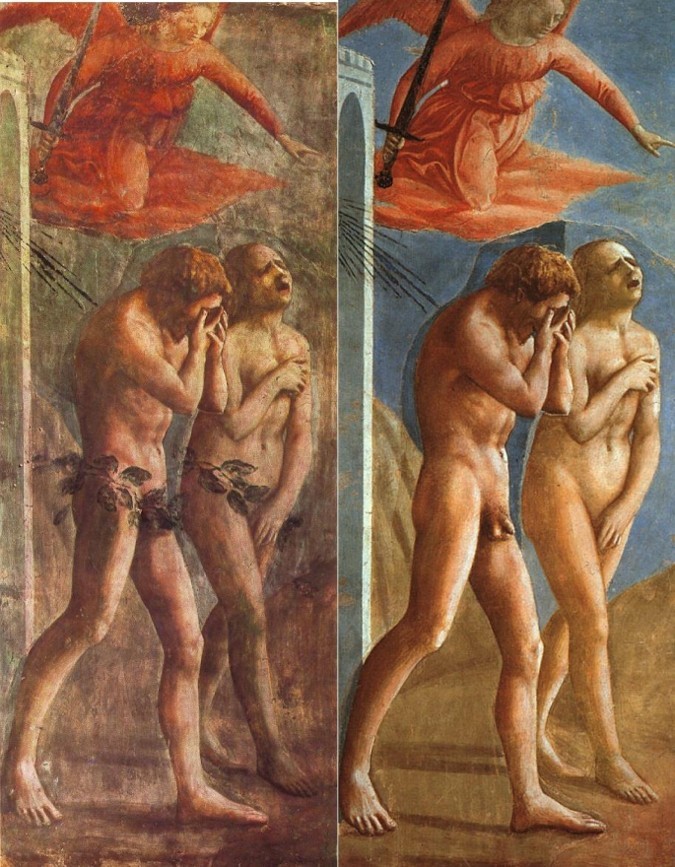
45. Masaccio: Expulsion of Adam and Eve from Paradise.
(Capella Brancacci-Carmine. Florence.)
See how the
artist's attention is directed not to the Biblical story in
itself but to the question: How will human beings look when they
have been through the experience of Adam and Eve? We must admit
that for his time the artist's answer is magnificent.
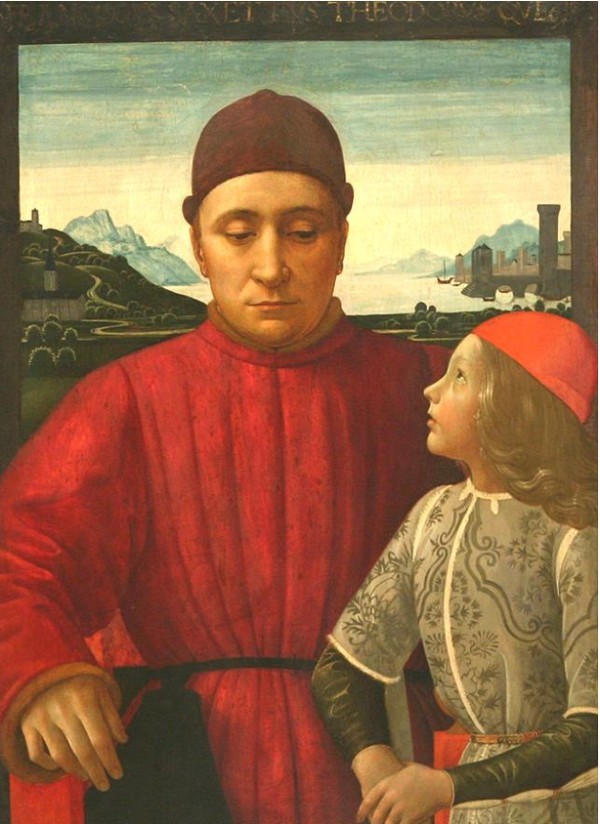
46. Ghirlandajo: Portrait, Framseslo Sassetti and Son.
(London.)
I need scarce make
a comment. With Ghirlandajo we come to a time when the faculty to
portray man as man — to represent what is purely human in
his life — has reached a high level of perfection.
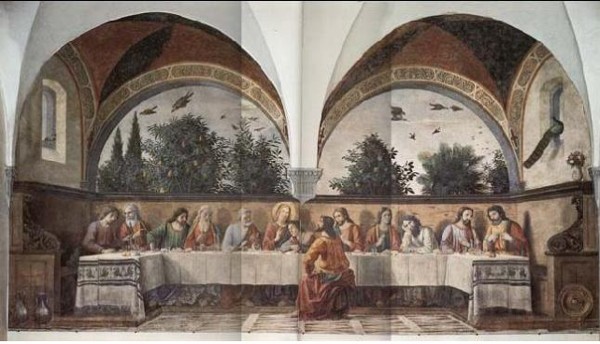
47. Ghirlandajo: Last Supper. (Fresco.) (Ognissanti.
Florence.)
Henceforth the Last
Supper is no longer merely represented (as in the picture that we
saw just now) so that the vision of those that behold it may be
kindled to an experience of the sacred action. No; the story of
the Last Supper is now taken as an opportunity to represent the
human beings. Though it is not yet so much so as in some later
pictures, nevertheless, we can already study here the
physiognomies of the disciples one by one, observing how their
human characters are working under the impression that has been
kindled in their souls. Such pictures bring home to us the
immense change in the whole artistic conception.
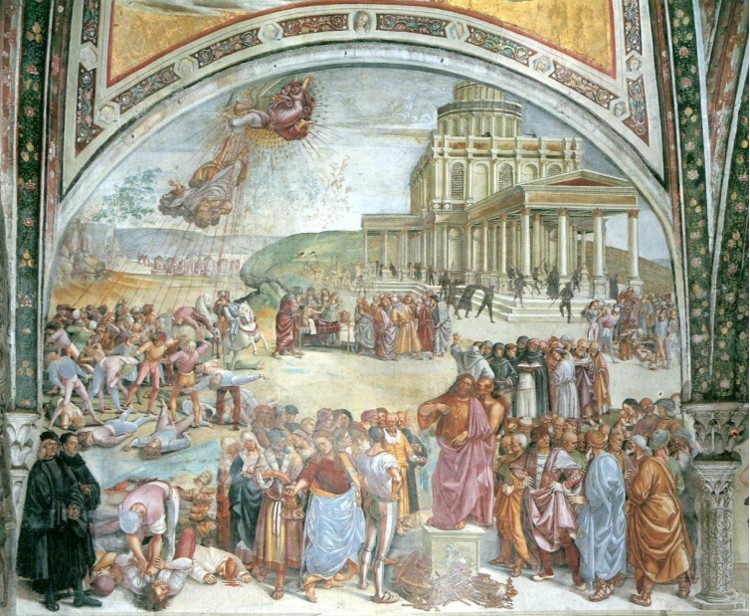
48. Signorelli: The Sermon of Anti-Christ. (Orvieto.) The
same comments would apply to this picture.
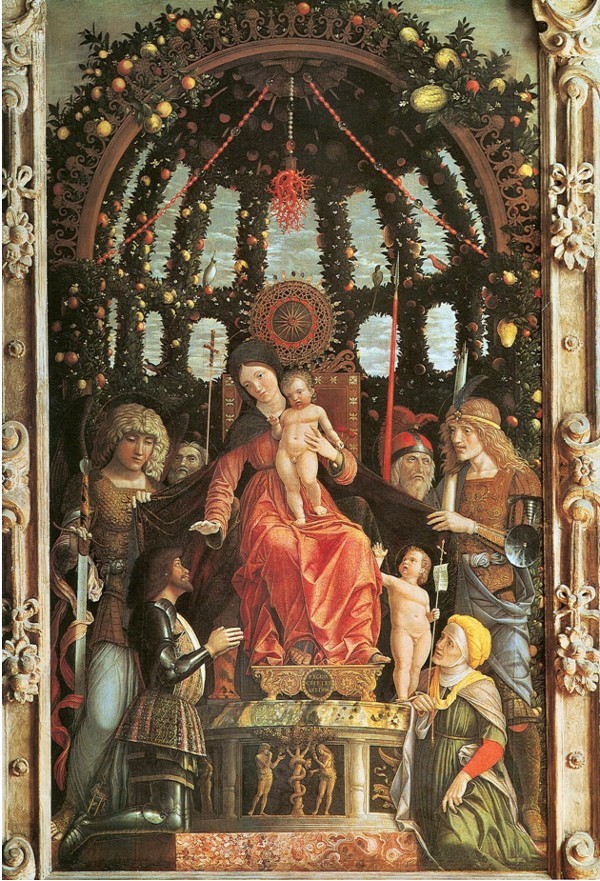
49. Mantegna: Madonna. (Louvre. Paris.)
So, too, with the
problem of the Madonna: the artists now are more concerned to
bring out what is human and feminine in the Madonna than to
represent the sacred fact. The sacred legend lives on; and, being
familiar to all, is made use of to solve problems of artistic
realism and to bring out the individual and human.
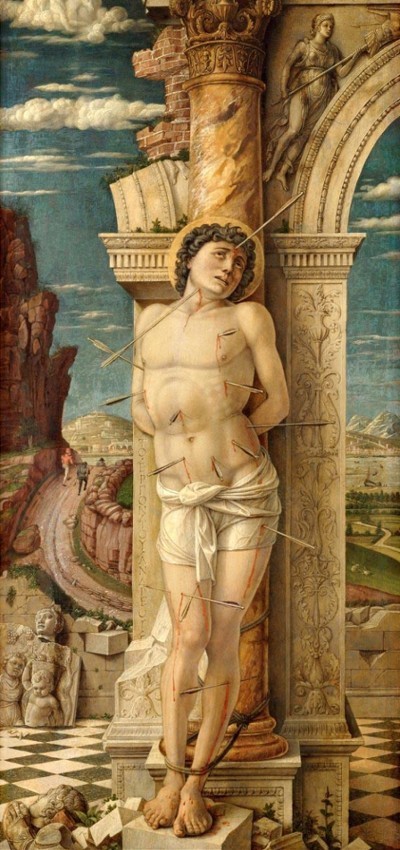
50. Andrea Mantegna: San Sebastian. (Vienna.)
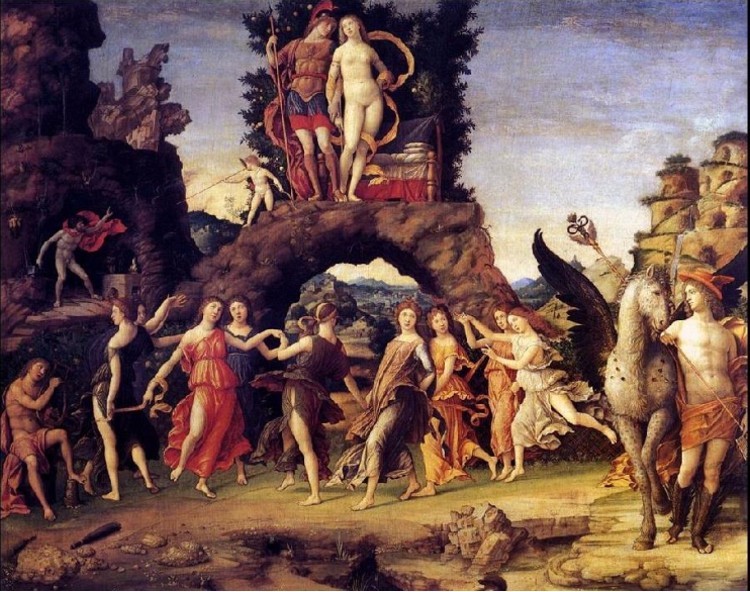
51. Andrea Mantegna: Parnassus. (Louvre. Paris.)
In these artists,
as the last pictures will illustrate, the Human impulse has
already grown so strong that they no longer feel the same
necessity to choose their subjects from the sacred legend. You
can scarcely imagine the entry into Giotto's pictures of any
other than a Christian subject. But when the Christian legend
came to be no more than the occasion for the artists to portray
the human being, they were presently able to emancipate the human
subject from the Christian Legend. So we see them going forward
to the art of the Renaissance, growing more and more independent
of Christian tradition.
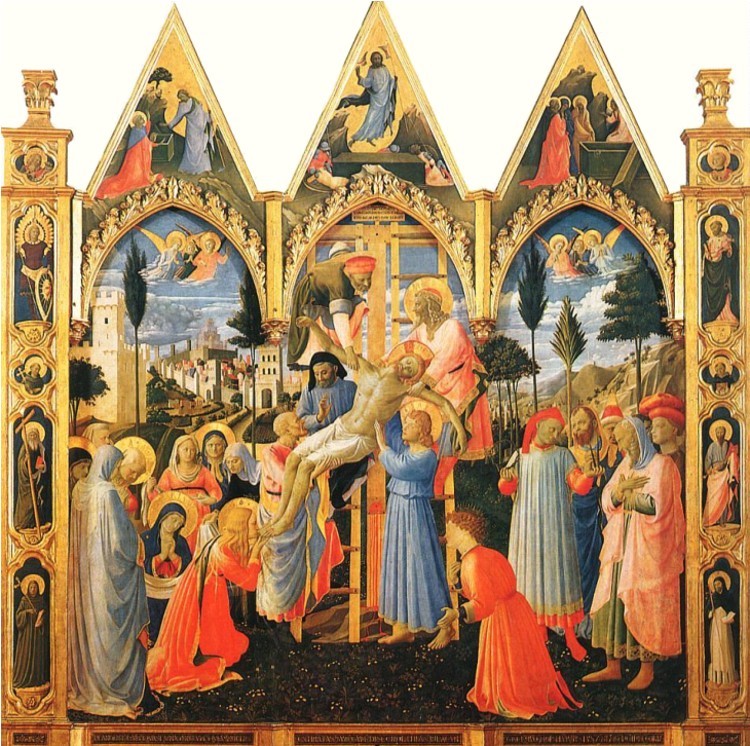
52. Fra Angelico: Descent from the Cross. (Academy.
Florence.)
Having shown a
number of pictures representing the realistic stream, if so we
may call it — the seizing of the Human on the Earth,
liberated from the Supersensible — we now come to the
second stream above-mentioned, of which Fra Angelico is one of
the greatest representatives.
It is, if I may so
describe it, a more inward stream,a stream more of the soul. The
artistic evolution which we followed hitherto was taken hold of
more by the Spirit. In Fra Angelico we see the Heart, the soul
itself, seeking to penetrate into the human being. It is
interesting to see once more, in the wonderfully tender pictures
of this artist, the attempt to grasp the individual and human,
yet from an altogether different aspect, more out of the soul.
Indeed, this lies inherent in the peculiar colourings of Fra
Angelico, which, unhappily, we cannot reproduce. Here everything
is felt more out of the soul, whereas the emancipation of the
Human which appeared in the other realistic stream, came forth
more out of the human Spirit striving to imitate the forms of
Nature.
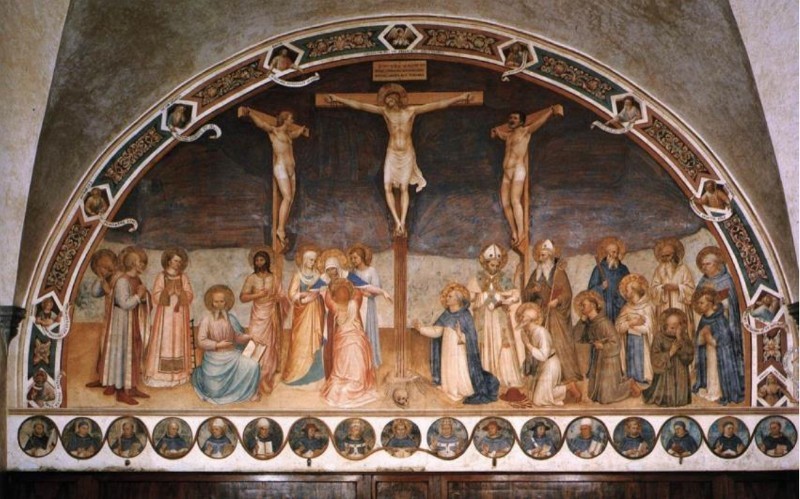
53. Fra Angelico: Crucifixion. (San Marco. Florence.)
It is by the path
of the soul, as it were, that the soul-content of Christianity
pours in through Fra Angelico. Hence the phenomenon of Fra
Angelico is so intensely interesting. Formerly, as we have seen,
a supersensible and spiritual content poured through the
evolution of Christianity, and took hold also of the world of
Art. Then the attention of man was turned to the world of Nature
— Nature experienced by the soul of man. We have seen how
the same impulses, living as a simple religious enthusiasm in St.
Francis of Assisi, found artistic expression in Giotto.
Henceforth, man's vision was impelled more and more to an outward
naturalism. But in face of all this realism, his inner life seeks
refuge, as it were, in the soul's domain, tending, again, rather
to melt away the sharper lines of individuality, but striving all
the more intensely to express itself, as a life of soul, in outer
form. For the soul's life holds sway, pervading all the details
in the work of Fra Angelico. It is as though the soul of
Christianity took flight into these tender pictures, so widely
spread abroad, though the most beautiful are undoubtedly in the
Dominican Monastery at Florence.
Thus while the
Spirit that had once held sway in vision of the Supersensible was
now expended on the vision of the Natural, the soul took refuge
in this stream of Art, which strove not so much to seize the
physiognomy — the Spirit that is stamped on the expressions
of the human countenance and of the things of Nature — but
rather to convey the life of soul, pouring outward as a living
influence through all expression.
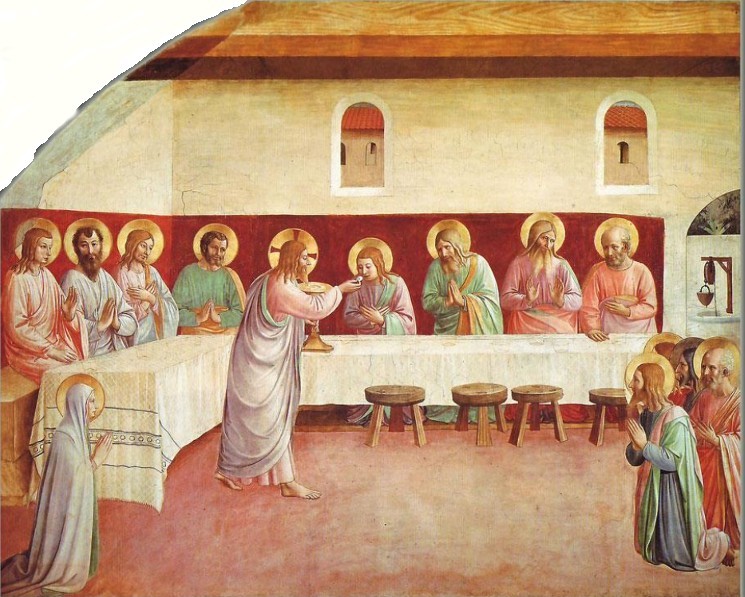
54. Fra Angelico: The Last Supper. (San Marco,
Florence.)
You will remember
the picture of the Last Supper which we showed just now. There,
everything depended on an answer to the question: How does Nature
reveal the Spirit? How does Nature impress on the external
features of men the signature of their experience in this event?
Here, on the other hand, you see how all the characters are
concentrated on a single feeling, and yet this single quality of
soul finds living expression in them all. Here is essentially a
life of soul, expressed through the soul; while in the former
picture it was a life of the Spirit, finding a naturalistic
expression. Down to the very drawing of the lines you can see
this difference. Look at the wonderful and tender flow of line.
Compare it with what you will remember of the former picture of
the Last Supper.
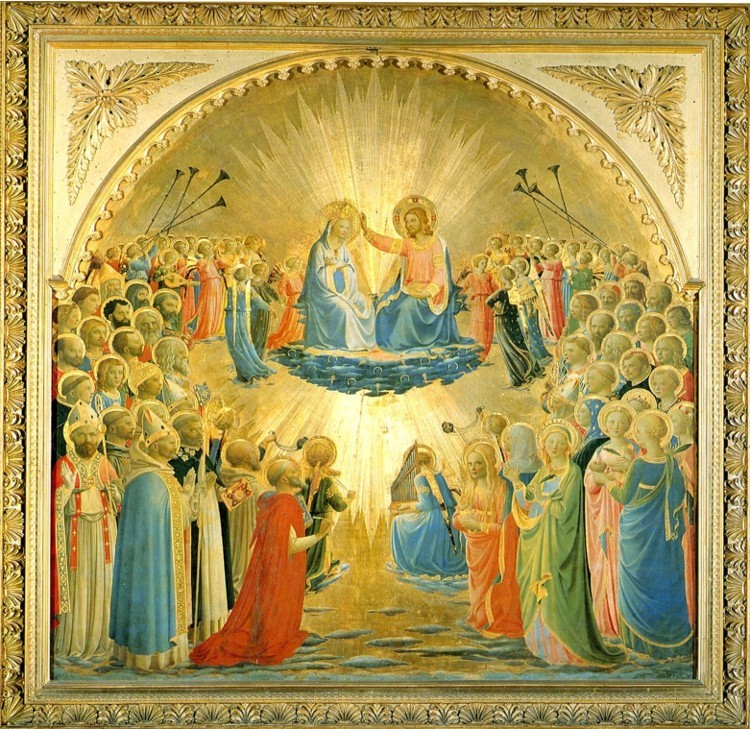
55. Fra Angelico: Coronation of the Virgin Mary. (San
Marco, Florence.)
See what a quality
of soul is poured like a magic breath over this picture.
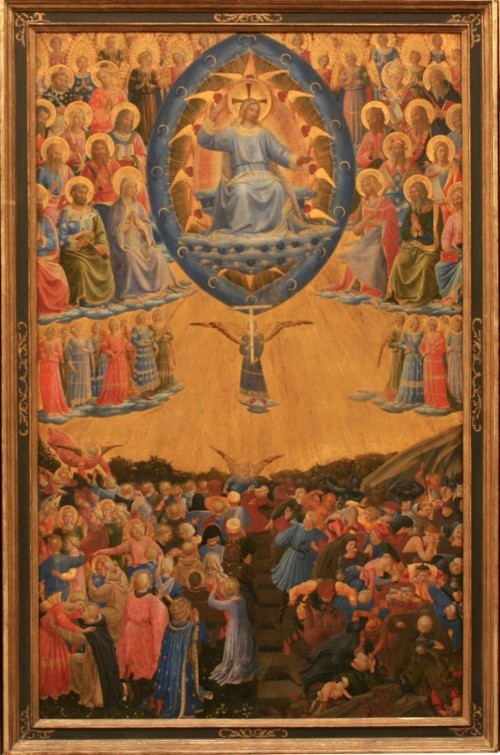
56. Fra Angelico: (from) The Last Judgment. (Museum.
Berlin.)
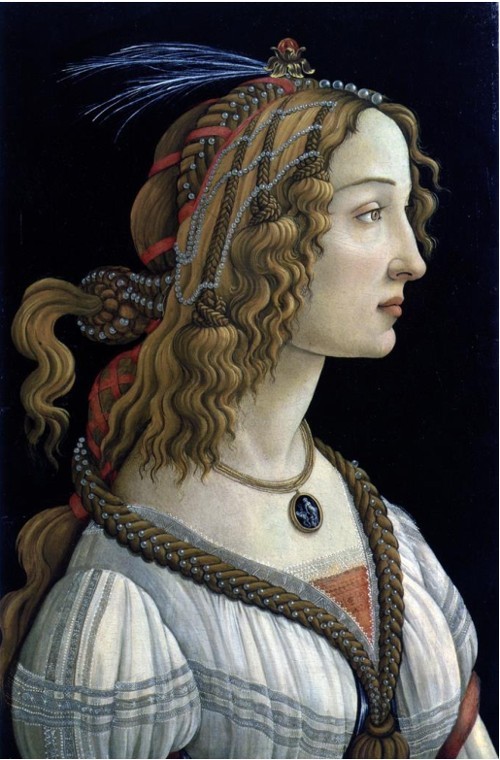
57. Sandro Botticelli: Lucrezia Tornabuoni.
(Frankfort.)
It is interesting
how in Botticelli the same artistic impulse, which we found in
Fra Angelico, is transferred — if I may put it so —
to altogether different motives. Botticelli, in a certain
respect, is most decidedly a painter of the life of soul. Yet he
again emancipates, within the life of soul, the Human from the
general Religious feeling which pervades the work of Fra
Angelico. He emancipates the human working once more towards a
certain naturalism in the expressions of the soul.
Compare this
portrait with the head we saw before, by Ghirlandajo. In that
case something essentially spiritual found naturalistic
expression, while here we see an abundant life and content of the
soul even in the drawing of the lines.
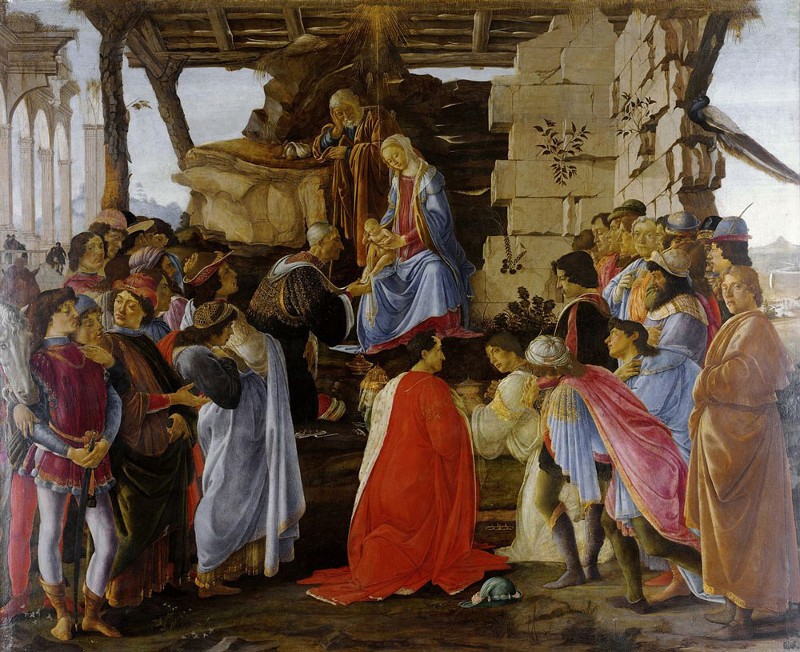
58. Sandro Botticelli: Adoration of the Magi. (Uffizi.
Florence)
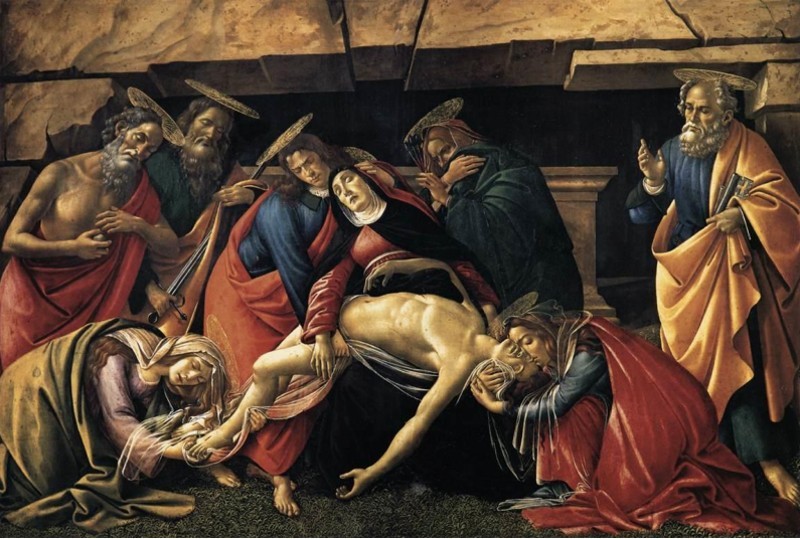
59. Sandro Botticelli: Pieta. (Alte Pinakothek,
Munich.)
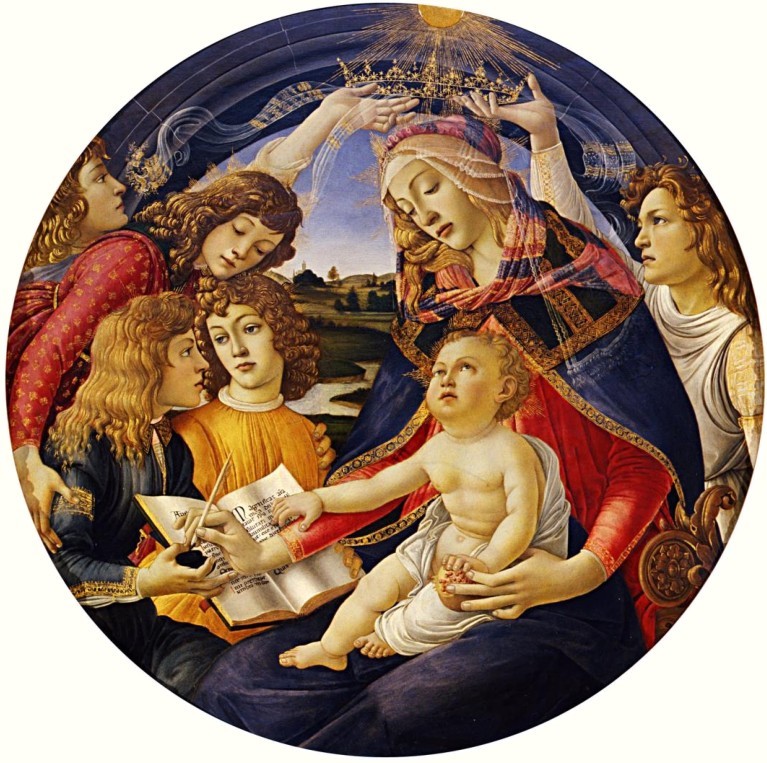
60. Sandro Botticelli: Coronation of the Virgin. (Uffizi.
Florence)
Following on Fra
Angelico, we have shown a series of Botticelli's so as to gain an
impression of the progress in the painting of the soul's life, in
contrast to the Spirit which we found in Masaccio and
Ghirlandajo. These, then, were the two directions that grew
directly out of the impulses proceeding from Giotto —
impulses handed down through Giotto, and through Donatello in
another sphere, down to these painters.
In the further
course of evolution on these lines, we now come to the great
Renaissance painters, of whom I still wish to show you a few
pictures in this lecture. When we have a picture like this of
Botticelli's before us, we realise the extraordinary intensity of
progress from the 14th to the 15th and on into the 16th century
— from the portrayal of the purely Human, In such artists
as Ghirlandajo we see the Spiritual, absorbed into the sphere of
Nature, brought to a high level of expression. Here in this other
stream we see a rich life of soul, come to expression, even in
the draughtmanship. In course of time men had attained the
knowledge of the human form, with all its powers of expression.
It was as though, from the starting-point of Heaven, Earth had
been conquered by mankind. That deepening of life which had come
about through Christianity passed more and more into the
background, and it was as though the object now were to
understand man as such in a far deeper way. The heavenly domain
became a path of progress, towards the more perfect expression of
the inner being of man as it stamps itself upon his outer
features, and upon all that comes forth outwardly in the
relationships of men to one another, in their life together. It
is the conquest of the realm of Man, by the most varied paths,
which comes before us here so wonderfully.
And now we see the
union of all these impulses in the great artists, Leonardo,
Michelangelo and Raphael. Let us observe a few of Leonardo's
pictures. We shall find in him a synthesis of the varied
strivings which came be ore us in the other pictures. For in a
high degree, the Leonardo da Vinci, there is a working-together
of the Spiritual with the life of the soul — in his
drawing, in his composition and in his power of expression.
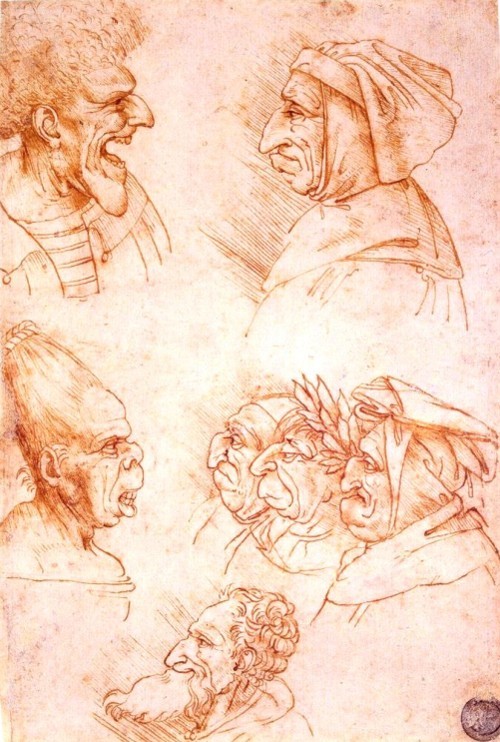
61. Leonardo da Vinci: Sketches and Caricatures.
(Windsor.)
To begin with I
have selected some sketches and drawings by Leonardo, from which
you may see how he endeavoured to study man in a fully realistic
way. This, of course, was in a time when all that had been gained
in the former periods was there to influence the artist. It is
characteristic of Leonardo how radically he seeks to bring out
the full expressiveness of man; he tries to seize the human being
as a whole, and bring him forth to perfection in his drawing. He
seeks to enhance his power of expression to the highest point by
studying and holding fast all human needs. This was only possible
in the flower of an artistic epoch containing all the works which
we have seen today — the penetration of the human being in
the Spirit and in soul.
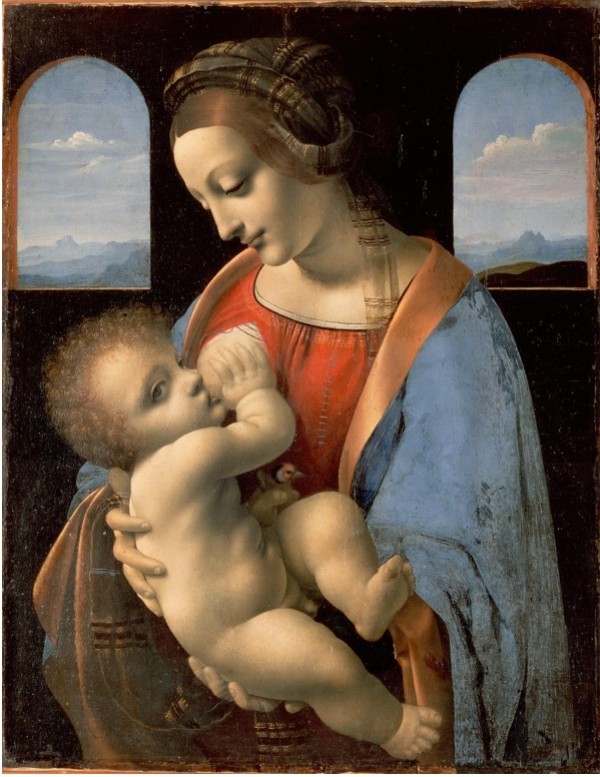
62. Leonardo da Vinci: Madonna detta. (Eremitage, St.
Petersburg.)
More, as I said,
you see united all that had formerly been striven for by separate
paths.
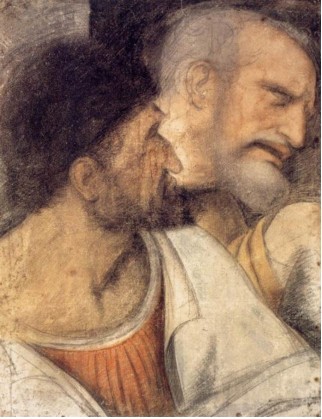
63. Leonardo da Vinci: Heads of Apostles. (Weimar.)
These are the heads
of the Apostles from the famous fresco at Milan, — the Last
Supper, which, also, is scarcely visible today, for only isolated
patches of colour now remain. We see that in this great artistic
epoch the sacred legend merely provided a foundation for the
working-out of human characters. Especially in his Last Supper,
Leonardo is at pains to study the single human characters. We see
him working very, very long at this wonderful picture, for he
wanted to study the human characters in all detail. We know how
often he disappointed his clients — the dignitaries of the
Church. Thus, after long labour, he had not finished Judas
Iscariot, and when the Abbot, high dignitary that he was, kept
pressing him to finish it at last, his answer was that hitherto,
alas, he had not been able to finish it since he lacked a model
for Judas Iscariot; but now the Abbot himself, if he would kindly
sit for him, would provide an excellent model for the
purpose.
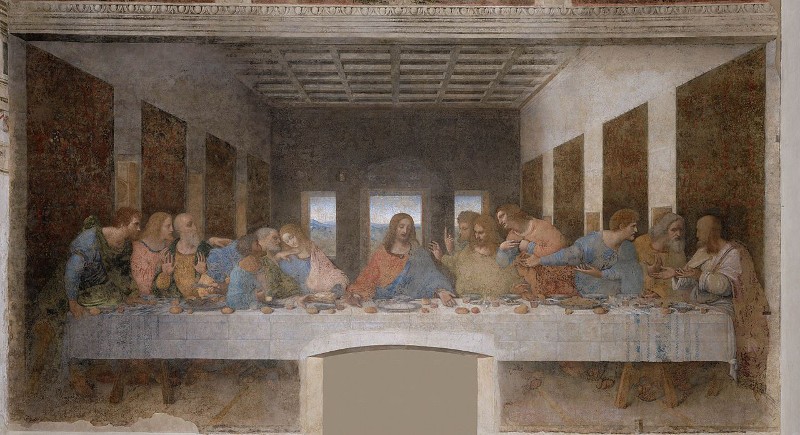
64. Leonardo da Vinci: Last Supper.
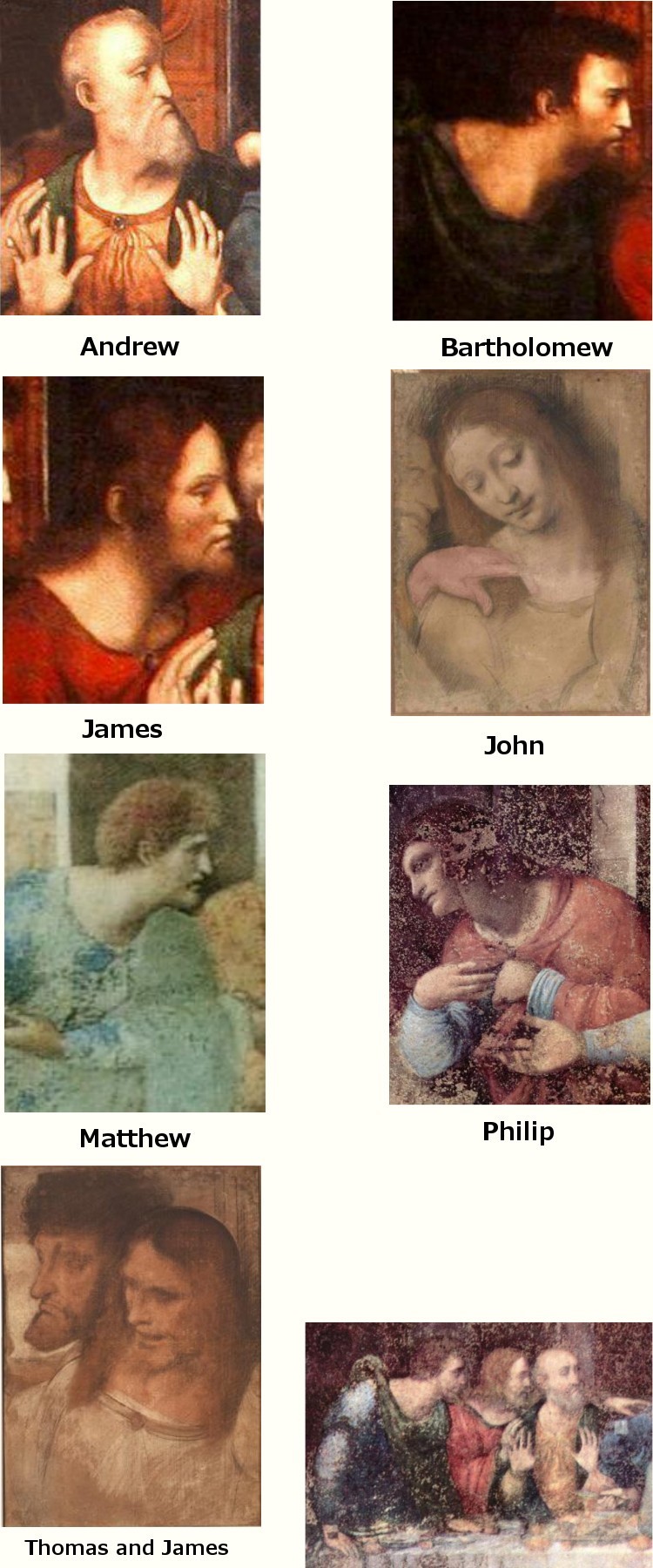
64a. Leonardo da Vinci: Heads of Apostles. (Weimar.)
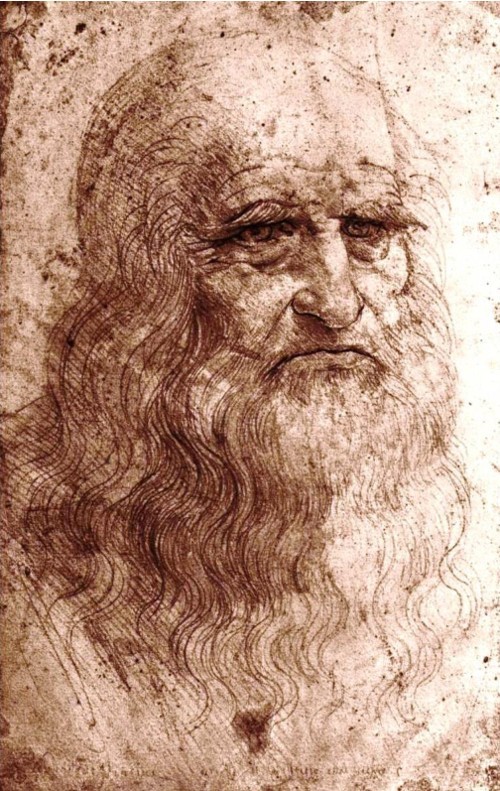
65. Leonardo da Vinci: Portrait of Himself. (Milan.)
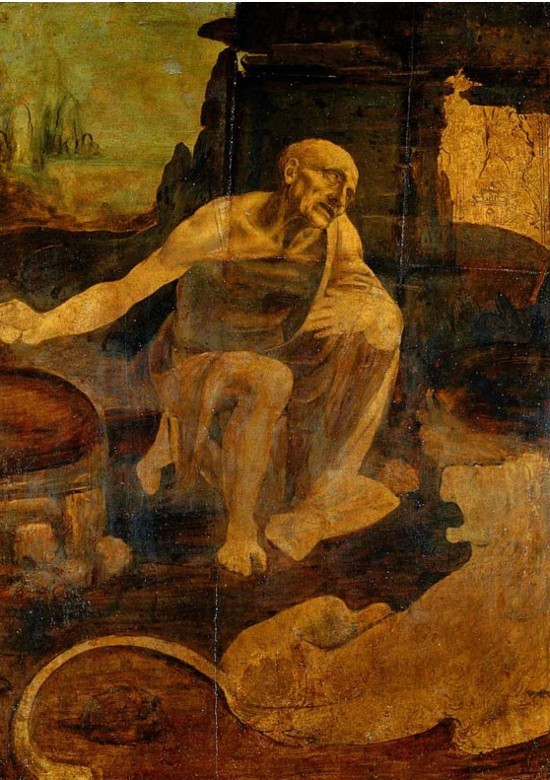
66. Leonardo da Vinci: St. Jerome. (Vatican. Rome.)
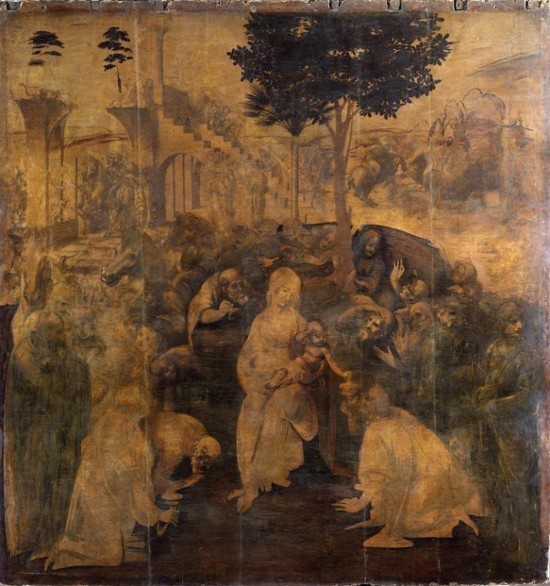
67. Leonardo da Vinci: Adoration of the Magi. (Uffizi.
Florence.)
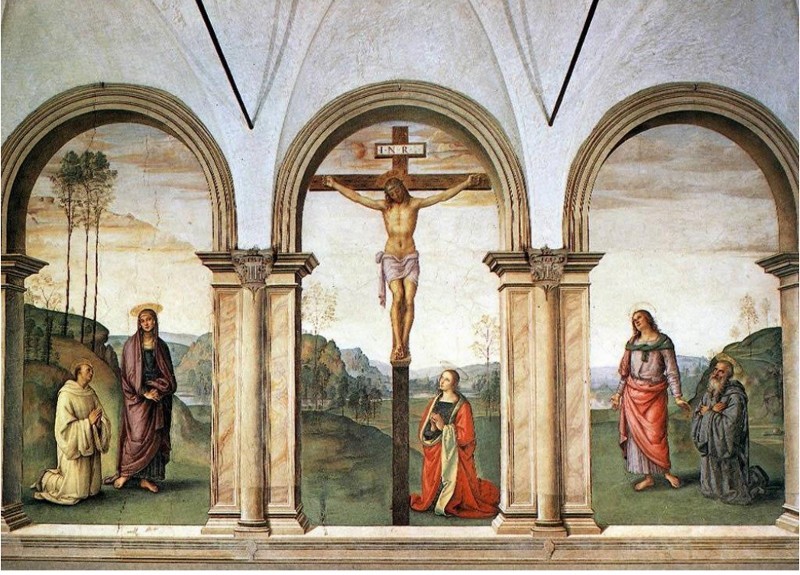
68. Perugino: Crucifixion: (Sta. Maria dei Passi.
Florence.)
We go on in this
classical epoch. I beg you to observe this picture by Perugino,
Raphael's teacher, to see how Raphael's art grew out of his
predecessor's. In Perugino a new element makes its appearance:
— a deep religious quality which tries to find expression
in the composition, combined with a powerfully architectural
imagination. On this, the greatness of Raphael very largely
depended.
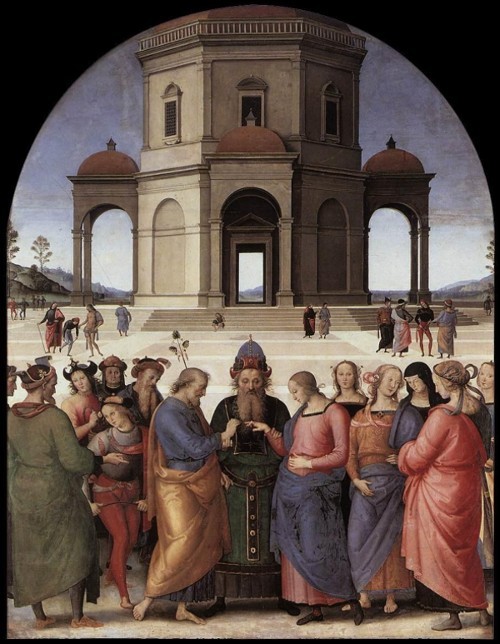
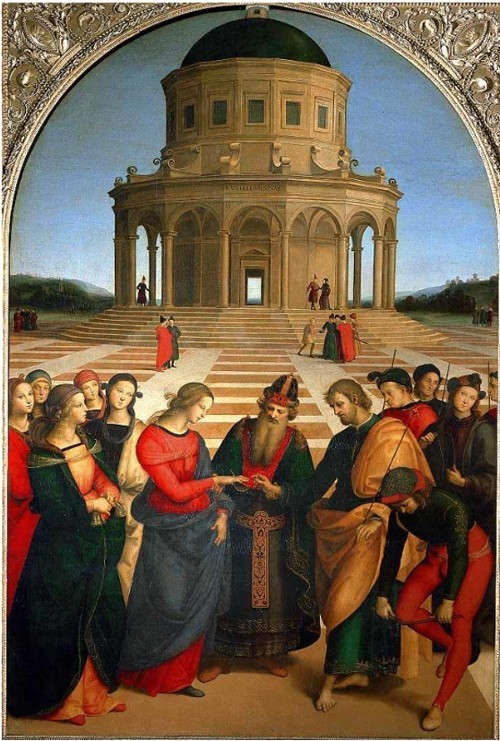
69. Raphael and Perugino: The Betrothal.
Look at these two
pictures: You will see the one actually growing out of the other;
you will recognise how Raphael, starting from his teacher,
attained his greatness, receiving the ripest fruits from the
different streams which we have learned to know this evening;
Raphael brings soul and Spirit into his pictures and combines
them with that element of composition which came from his
especial schooling.
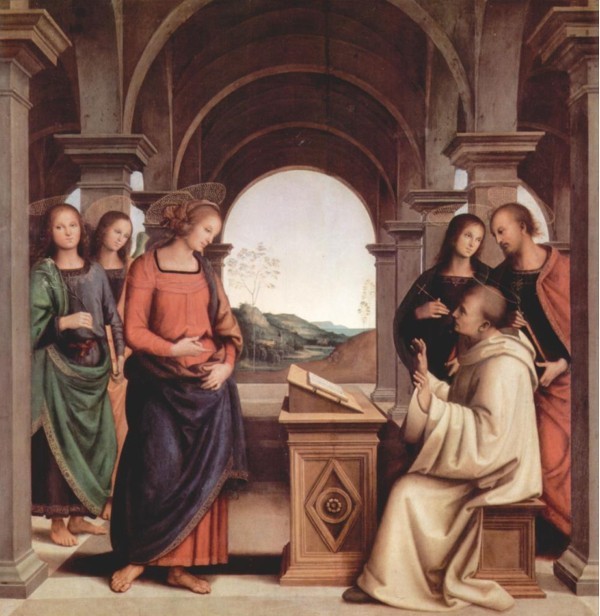
70. Perugino: Vision of St. Bernard. (Alte Pinakothek.
Munich.)
You will remember
the earlier picture of the 'Vision of St. Bernard' which we saw
this evening. Consider the great difference. In the former case
there was an effort to make the Spirit powerfully active in all
that was brought into the picture. Here we see a pure element of
composition, contriving to express what is, indeed, the chosen
motif of the picture but does not penetrate it fully. Perugino
cannot yet deepen his composition so that a living soul speaks
out of it. Nevertheless, we see how great a part this element of
composition plays in his school of painting.
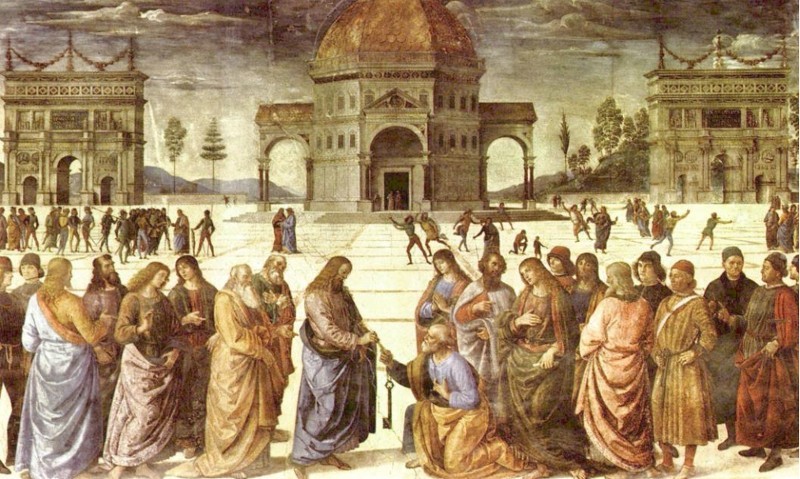
71. Perugino: The Giving of the Keys to St. Peter.
(Sistine Chapel. Vatican. Rome.)
Here, then, where
Raphael receive' such powerful influences, we see the entry of an
element of composition. You will, of course, see how great a part
it plays in Raphael. In the former pictures we cannot speak of it
in the speak of it in the same way as here. The composition was,
rather, the result of a totality, — a totality which the
artist felt more as a living organism. Man, too, after all, is
composed; but though he is composed of head and arms and legs and
so forth, we cannot really call this a 'composition'; for in man
everything proceeds as from a centre, and we feel his composition
— of arms and legs, of head and trunk — as a natural
totality, a thing that goes without saying. Here in this picture
you not feel it as a natural totality, a thing that goes without
saying. You feel it definitely, purposely composed; whereas you
will find the earlier compositions flowing more out of a single
whole. Here, you see, the whole is placed together; it is
literally composed.
Proceeding,
therefore, from the 13th, 14th, 15th centuries, we recognise the
one stream which seeks to conquer Nature through the Spirit, and
leads on to a higher stage of realism. Side by side with it we
see another stream which seeks to conquer Nature from the aspect
of the soul. And now, coming across from Central and Eastern
Italy where Raphael and his predecessors had their home, we see
this power of composition, this working from the single parts
towards the whole, whereas all the former streams still contained
an echo of the working from the whole into the single parts, a
thing that you could see most strongly, for example, in that
composition representing the spiritual rule of the Church pouring
out into the world, where everything was conceived out of a given
unity, and nothing was built up out of the single details, as it
is in this case.
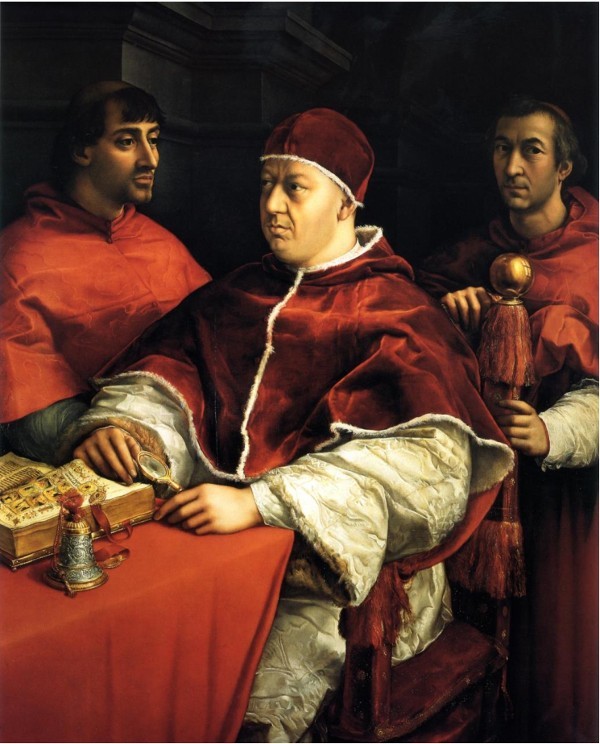
72. Raphael: Pope Leo X. (Pitti Gallery. Florence.)
See how the
spiritual element finds its way into the soul of Raphael —
I mean, all that has been achieved by that spiritual element
which grew into Naturalism.
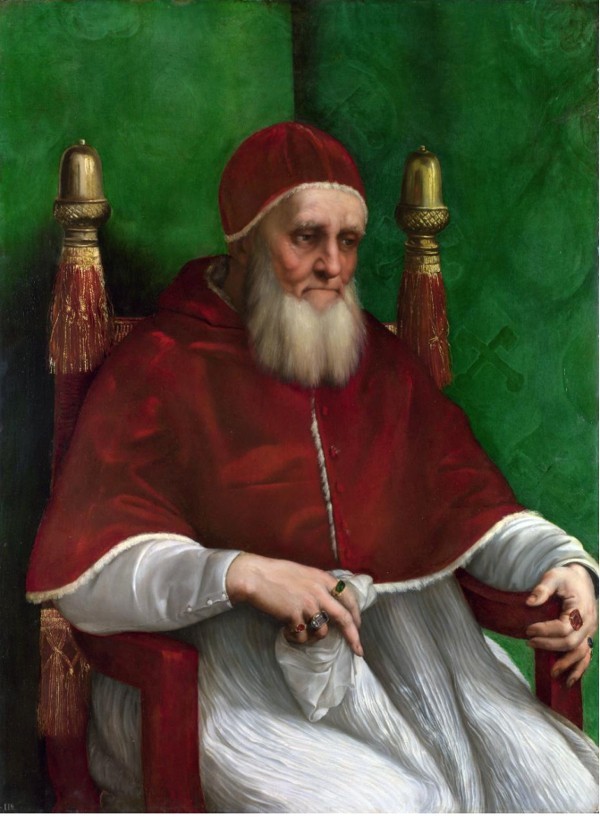
73. Raphael: Pope Julius II. (Uffizi. Florence.)
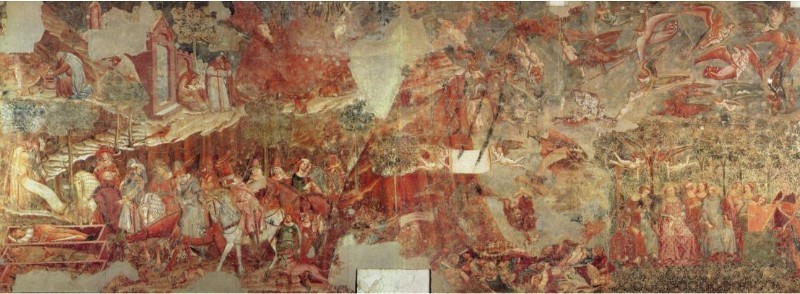
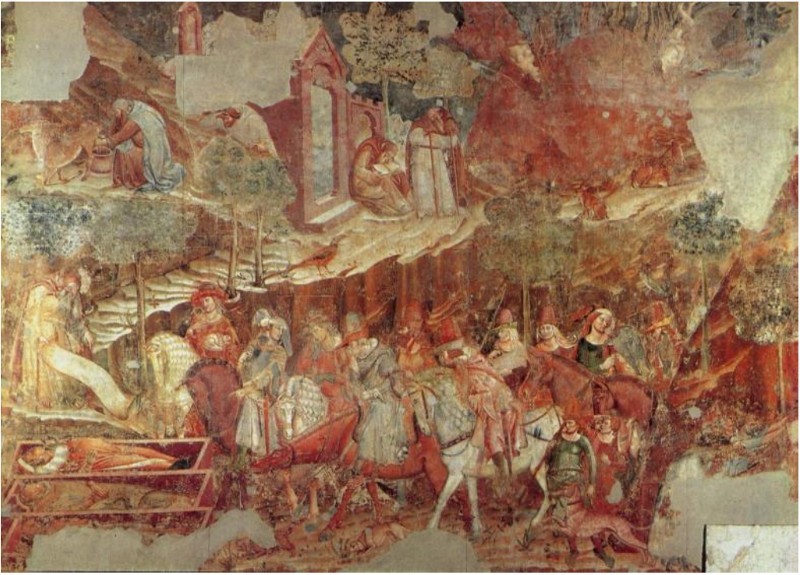
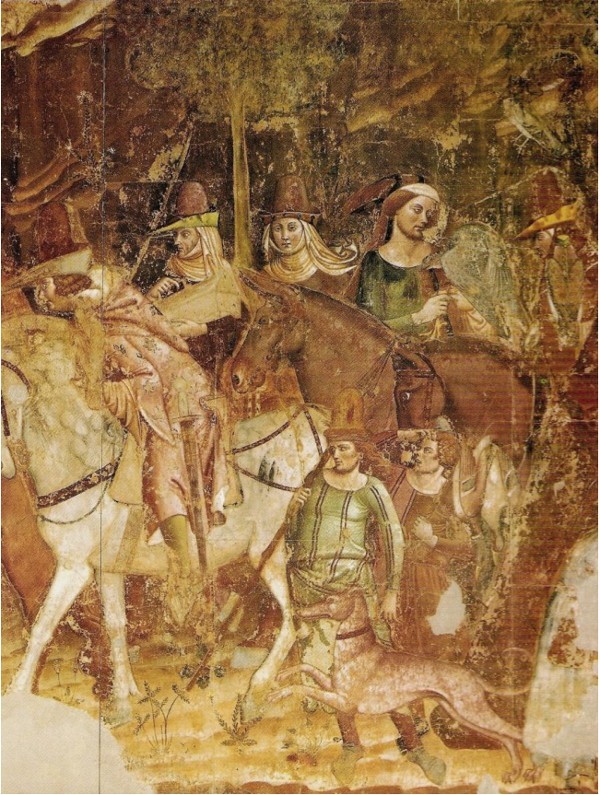
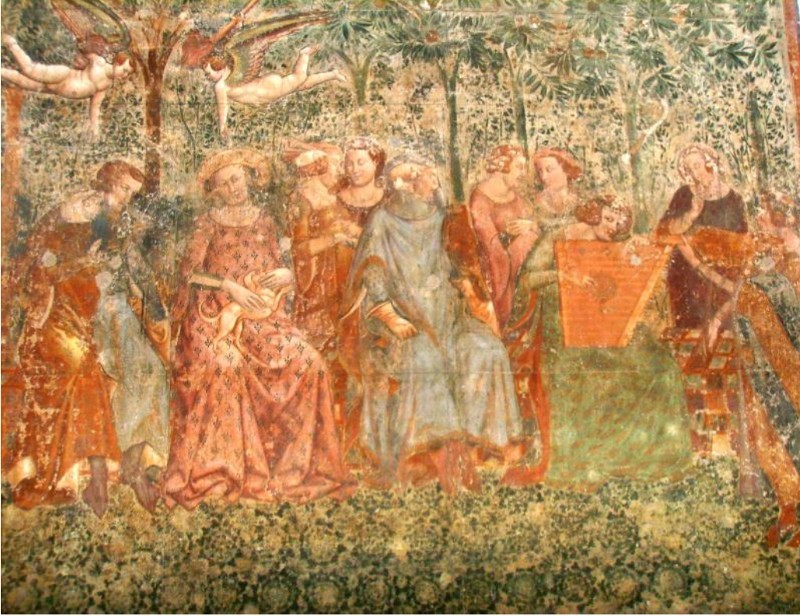
74. Orcagna: Triumph of Death. (Campo Santo. Pisa.)
I have inserted
this last picture to show how the element of allegory still
worked on. I drew attention to it in Giotto. It worked on along
with all the other streams; indeed, it was the one thing that
more or less remained of the earlier more spiritual conception.
This one thing remains: — this element of abstract allegory
which is especially to be found in the pictures in the Campo
Santo at Pisa, magnificent as they are in many respects. It
belongs, indeed, to an earlier time. Nevertheless, I wanted to
show you how this allegorical element still worked on even in a
later age.
All these things,
then, were living in the feeling of the human being, — a
spiritual power and a life of soul poured out into Naturalism;
and withal, no longer an ability to grasp the whole as such, but
purposeful. composition. Lastly, the remnants of allegory.
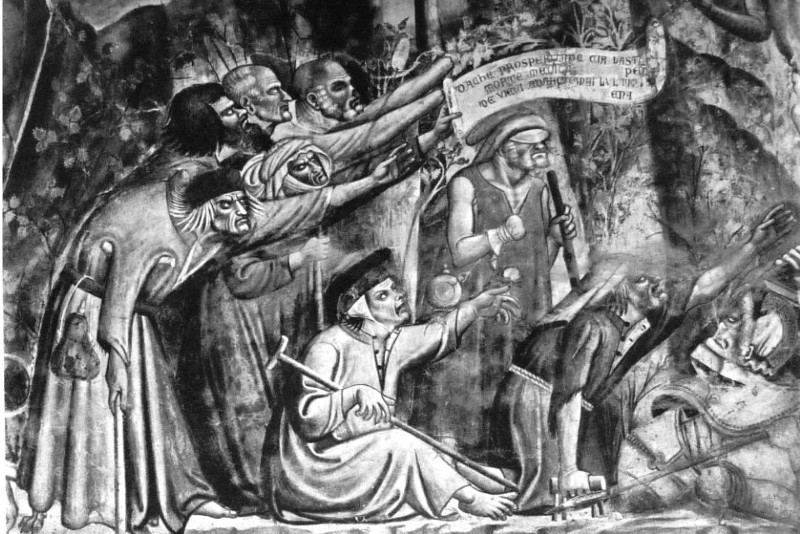
75. Orcagna: Triumph of Death. Campo Santo. Pisa.)
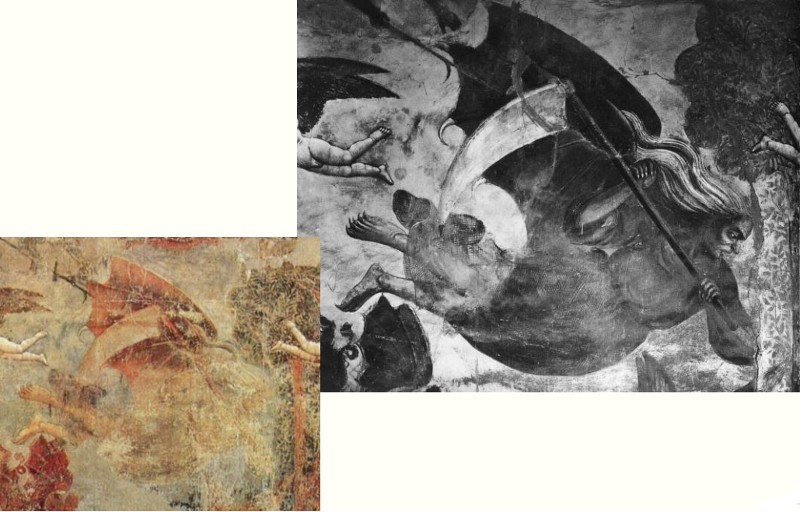
76. Orcagna: Triumph of Death. (Campo Santo. Pisa.)
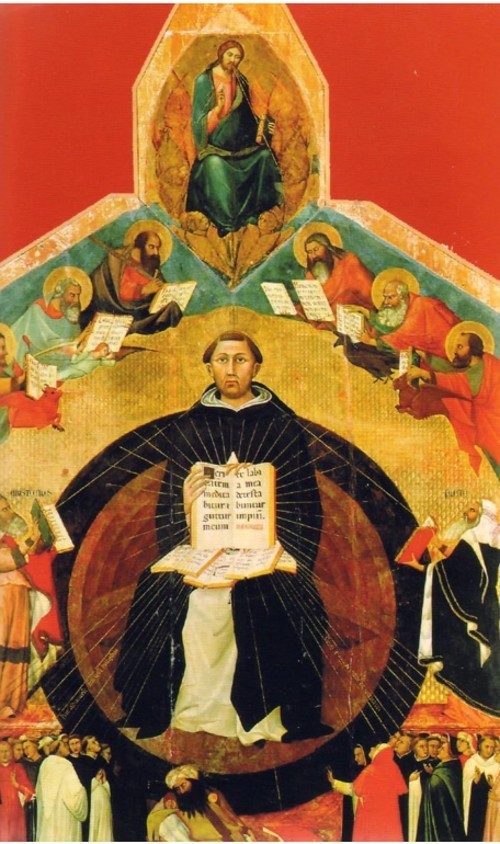
77. Francesco Traini: St. Thomas Aquinas. (Sta. Caterina. Pisa.)
In this picture you
see once more the working-on of allegory. It is intended to
represent the influence of the scholastic doctrine, on the one
hand downward to the Earth, even to the conquest of heresy, and
on the other hand upward into the heavenly regions where the rays
of what is living on the Earth are received into the midst of
sacred beings. What was conceived working, as it were, in the
spiritual substance of the Earth, is here expressed in allegory.
It is an allegory, but one derived from the reality. Here, then,
the last-named element — that of allegory — is taken
as a starting-point, not for the mere sake of allegory in itself,
but, rather, to express in allegory what they conceived as really
working, even as they represented it.
Thus we have tried
to understand the different streams. I will once more repeat
them: The Spirit striving into Naturalism; the life of soul,
growing ever more realistic in its expressiveness, even as the
artists grew more capable of portraying the soul's life in the
outward expression; the element of composition, placing together
single features in order that the whole might have a spiritual
effect; and, lastly, the element of allegory. We have traced
these influences, each and severally. Thus was built up what came
at last to full expression in the creations of Raphael,
Michelangelo and their successors. Throughout, we see a spiritual
force, passing through man by varied ways and channels, seeking
to conquer Nature. First we see the Spirit endeavouring to master
what comes to expression in the human being through the human
Spirit. Then the spiritual faculty of vision enters more and more
into man's grasp of outer Nature. Then, in such artists as Fra
Angelico and Botticelli, we see the entry of a life of soul. And
when the composition was no longer given as a matter of course
out of a spiritual vision, we witness the attempt to bring the
Spirit to expression by composition deliberately placed together,
in which direction Raphael achieved the highest eminence. Lastly,
we see how the longing to give voice to the great cosmic process
led to Allegory, and how Allegory itself grew into Realism, as
you can see in this very picture. Indeed, in Raphael it grew once
more into a perfectly natural spirituality, a spirituality that
works as a matter of course. I beg you to remember such a
composition as his 'St. Cecilia' at Bologna. Here we still see, a
central figure is set down with obviously allegorical intention,
seeking to represent the soul-life of the human being in its
connection with the Universe.
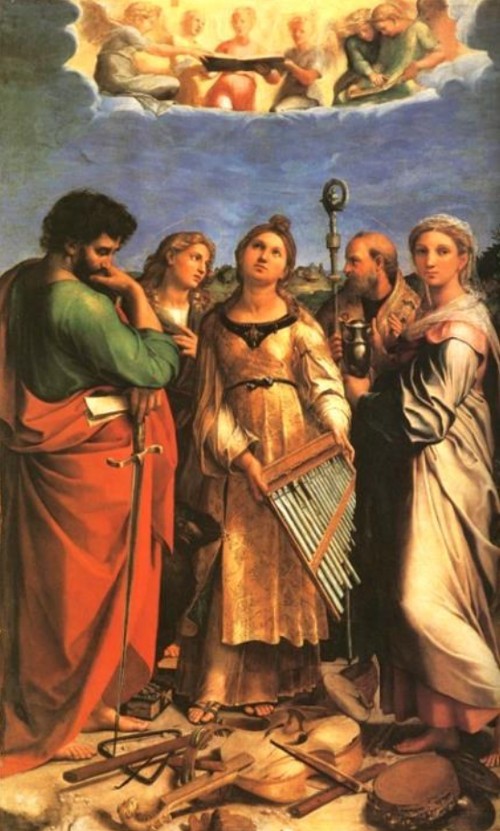
78. Raphael: Saint Cecilia (Bologna, Pinacoteca)
In Raphael's St.
Cecilia there is the central figures standing in the midst; yet
the thing has gone so far that the allegorical quality is
completely overcome, obliterated, as it were, so much so that
there is much argument today as to what this 'St. Cecilia' is
meant to express, though they need only to look up their
Calendars to see how closely the picture adheres to the
tradition. For in the legends of the Saint you will find all that
Raphael included in this wonderful creation. But to such an
extent did he attain Nature's power to express the Spirit and the
Soul in form, that we no longer notice all the Allegory that
underlies the picture. And that, indeed, is the great thing in
this epoch, attained by Michelangelo and Raphael. In all the
former streams, the impulses from which they come are
recognisable. Here, each and all, they are overcome to
perfection, with the attainment of a pure and fresh and free (for
that time fresh and free) vision and reproduction of the reality
around us, in its natural material content and in its soul and
Spirit. The works created by this age were based, indeed, on the
preceding evolution which we have described. Here, above all, we
recognise how such achievements must be preceded by many lines of
evolution, which, only inasmuch as they take their start from the
Spirit, lead to the recognition of the Spirit in the outer world.
Man must first seek the Spirit, then will he find the Spirit in
the outer world. Man must first feel and experience the Soul,
then will he find them also in the external Nature. Thus we see
how the Spiritual that was still at work in Cimabue, worked on
after him in Giotto, who in turn carried it outward as a means to
understand the forms of Nature. We see the spiritual content
radiating still from Giotto's work, applied still further by his
successors to apprehend the Spirit in the world of Nature. We see
how the deep soul-impulse that came through Francis of Assisi,
taking hold of the life of the soul in man himself, was expressed
with a certain artistic perfection in the Christian piety of Fra
Angelico. This impulse once again rays forth into the world; we
have the essence of Botticelli. Then (if I may so express it),
out of a kind of memory of the totality of vision which is lost,
the artist tries to piece together the single features into a
composition, thus creating a totality once more, so that the
Spirit — which was lost to immediate vision, to be used in
a new way in the taking hold of Nature, — might work again
from the totality. And at length we see, in the quest of
Allegory, the search for means of expression, leading in the last
resort to the overcoming of all Allegory; to the finding the
means of expression even in Nature herself. For to him who first
sets out to seek it, the free and open-minded vision of the outer
World itself will give what he desires. Nature herself is
allegorical; yet does she nowhere impose her allegories on us, or
let us see them outwardly as such. Man must learn what is there
to be read in the book of Nature. But at first he often has to
learn his reading in clumsy devious byways. In such a work as the
picture of St. Thomas which we saw before, we witness still a
clumsy and unskillful reading of the book of Nature. In Raphael's
St. Cecilia, on the other hand, we have a reading which contains
no longer any Allegory, no longer any of that abstract element
which has not yet arisen to the full height of Art.
Thus I think we
shall have gained a conception, how the great epoch of the
Italian Renaissance gradually came into being. Again and again, I
think, the vision of man will be directed to these times, to this
artistic evolution; for it lets us gaze so deeply into the life
and working of piety, of Wisdom and of Love in the human soul,
combined with the artistic fancy, striving to reproduce Nature
with a fresh and open mind. It lies not in the mere imitation of
Nature, but in the faculty of Man, with all that he has found in
his own soul, to discover again in Nature what is already there
in her, akin to the inmost experiences of the human soul. This, I
venture to hope, our descriptions today — however brokenly,
however imperfectly — may still have brought to light.
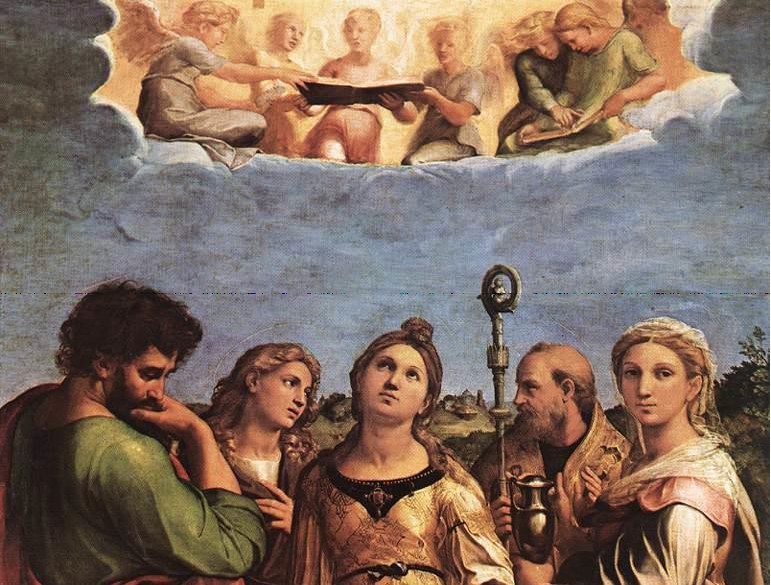
78a. Raphael: Detail of Saint Cecilia (Bologna, Pinacoteca)
|